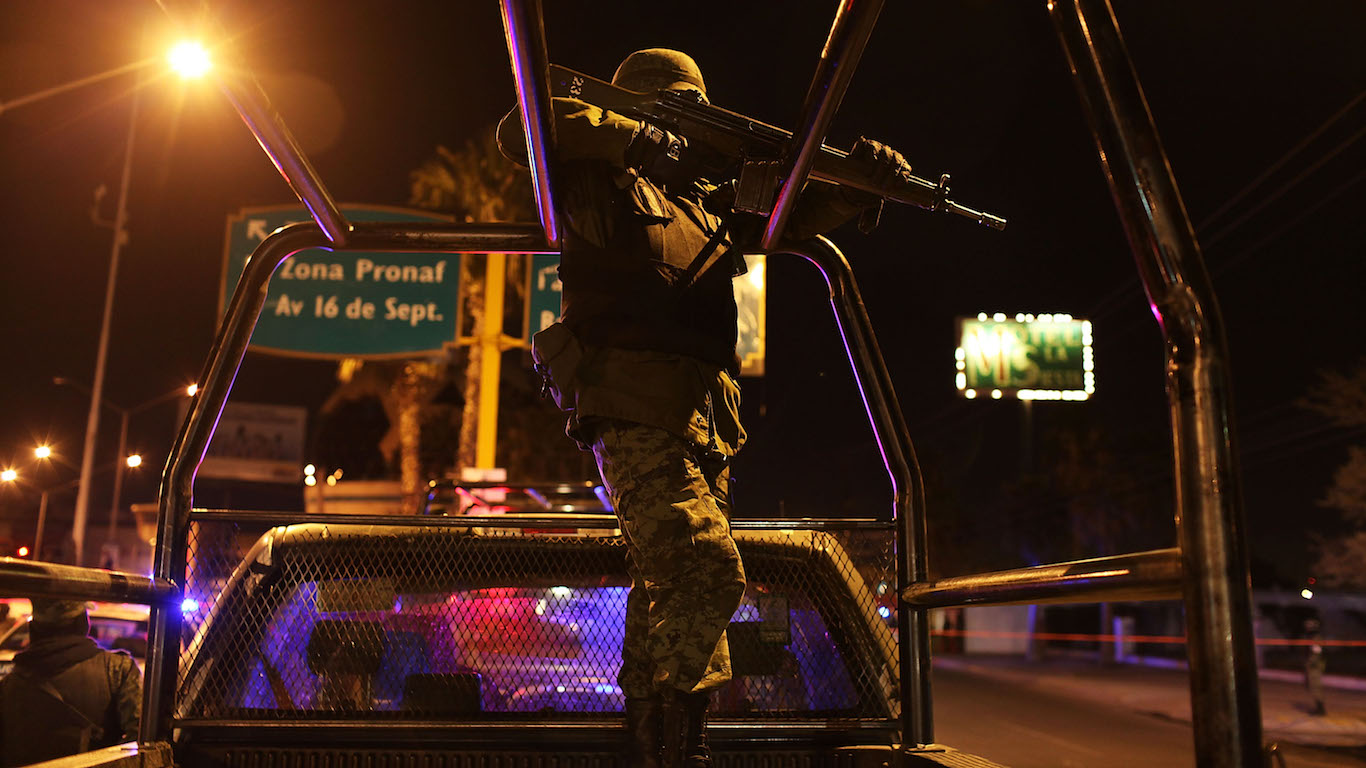
Just two years ago, Los Cabos, a Mexican holiday destination known for its pristine beaches, deep-sea fishing, and five-star hotel accommodation was off the radar of Mexico’s war against drug cartels and street-level criminals. But in just 12 months the number of murders in Los Cabos spiked by more than 500% to 365, or one murder a day, making the municipality of about 330,000 people the most dangerous city in the world.
This is one of the starkest details to emerge from data provided by El Consejo Ciudadano para la Seguridad Pública y la Justicia Penal (The Citizen Council for Public Security and Criminal Justice, a Mexico City-based advocacy group) in its 2017 report about the 50 cities in the world with the highest number of homicides per 100,000 residents. The report only considers cities outside of combat zones with populations greater than 300,000 that provide murder statistics. Murder statistics are closely tracked because they’re harder for investigators to rig (unlike other types of crime) and tend to indicate other types of crime are also prevalent.
Another big takeaway from the data: Latin America remains the most dangerous region in the world, with dozens of cities facing political unrest, gang violence, failed enforcement strategies, extreme poverty, joblessness and often crippling national economic conditions.
While Colombia’s efforts to reach peace with rebels have helped lower its murder rate, neighboring Venezuela is roiling with unrest and violence amid deep economic and political crises. Meanwhile, Brazil is struggling with increased criminal gang activity in cities across its northeastern region, although hardline policing tactics have reduced street-level violence in Rio de Janeiro and São Paulo.
There are 17 Brazilian cities on this year’s list, which used 2017 data, down from 19 in the previous year’s list, which used 2016 data. But three of the Brazilian cities are in the top 10, up from one last year. The number of Mexican cities on the list increased from eight in the 2016 report to a dozen in the 2017 report.
The U.S. cities of Detroit, Baltimore, New Orleans, and St. Louis remain on the list, as they have been for years, with homicide rates higher than those in some cities in Mexico and Brazil that made it to the list.
A high homicide rate does not necessarily mean tourists and business travelers are at greater risk. Most of these murders are committed by locals against locals. Using common sense and general precautions foreign visitors are typically not exposed to these crimes in most of these cities. Nevertheless, the U.S. State Department urges caution when traveling to these cities and recommends that travelers avoid certain areas of these cities or surrounding countryside completely.
Click here to see the most dangerous cities in the world.
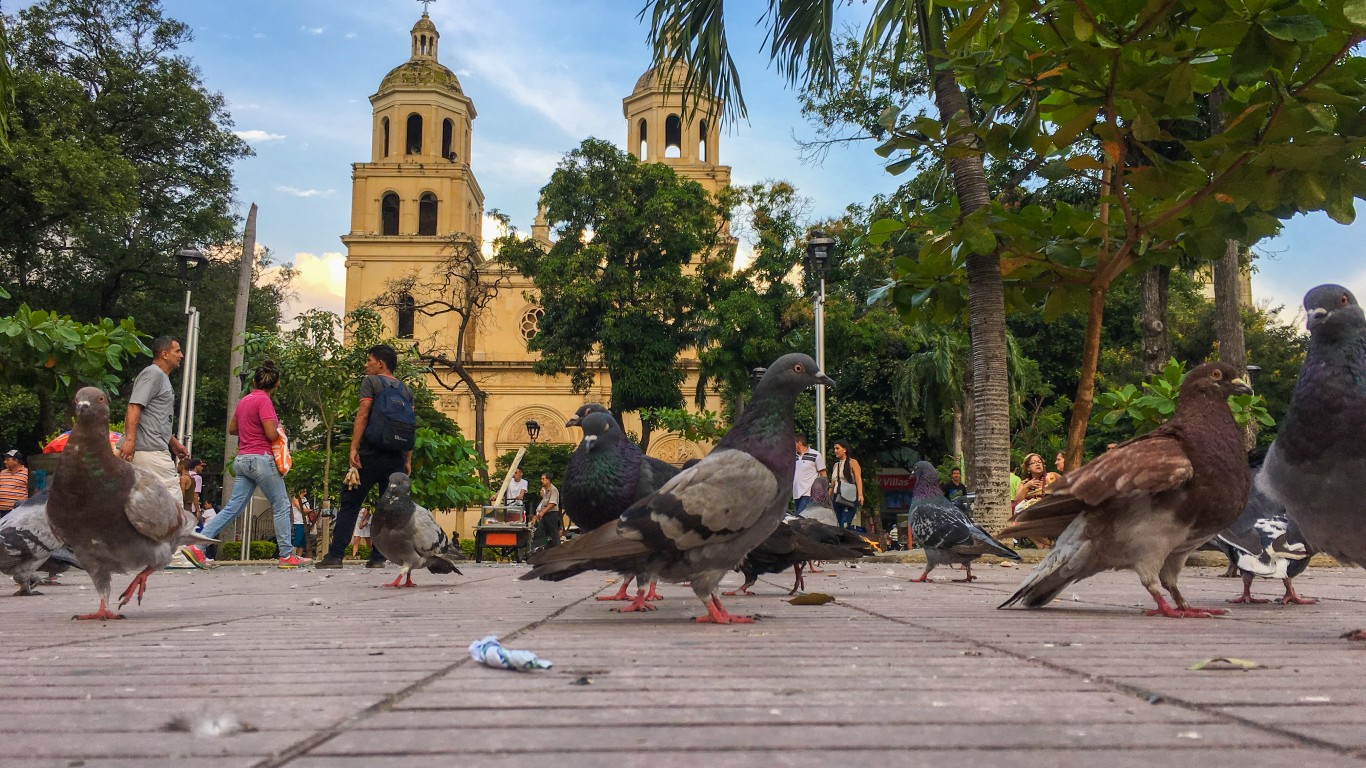
50. Cúcuta, Colombia
> Homicides per 100,000: 34.8
> 2017 homicides: 290
> Population: 833,743
The November 2016 peace deal between the government and FARC rebels not only put an end to a half-century of conflict in Colombia but also lowered the country’s homicide rate to its lowest level in 40 years. The end of this hostility had an overall calming effect in this country of 49 million people. As a result, one Colombian city was knocked off the list, and the ranking of the remaining three cities declined. The ranking of Cúcuta, which borders Venezuela in the country’s northeast, dropped to 50th from 48th.
[in-text-ad]
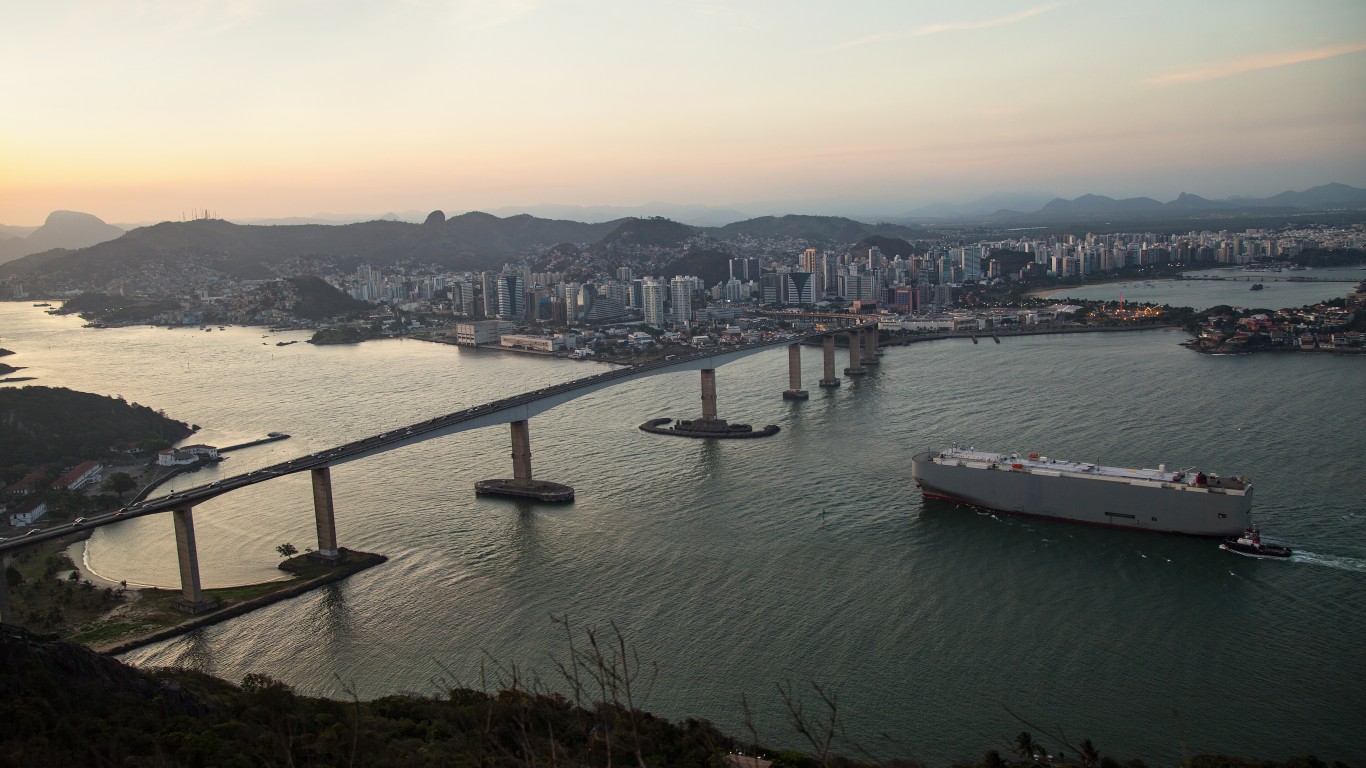
49. Vitória, Brazil
> Homicides per 100,000: 36.1
> 2017 homicides: 707
> Population: 1,960,213
When police in this city north of Rio de Janeiro went on strike in early February 2017, the effect was immediate. Five days after the strike began, more than 100 people had been murdered, compared to four in the entire month of January. Severe economic conditions and poverty, exacerbated by the 2014 Brazilian economic crisis, the worst in the country’s history, has caused a surge in crime and violence in many of the country’s larger cities. Though the economy finally recorded modest growth in 2017, the police strike was an ugly reminder of how tenuous the security situation can be in the country’s most violent cities.
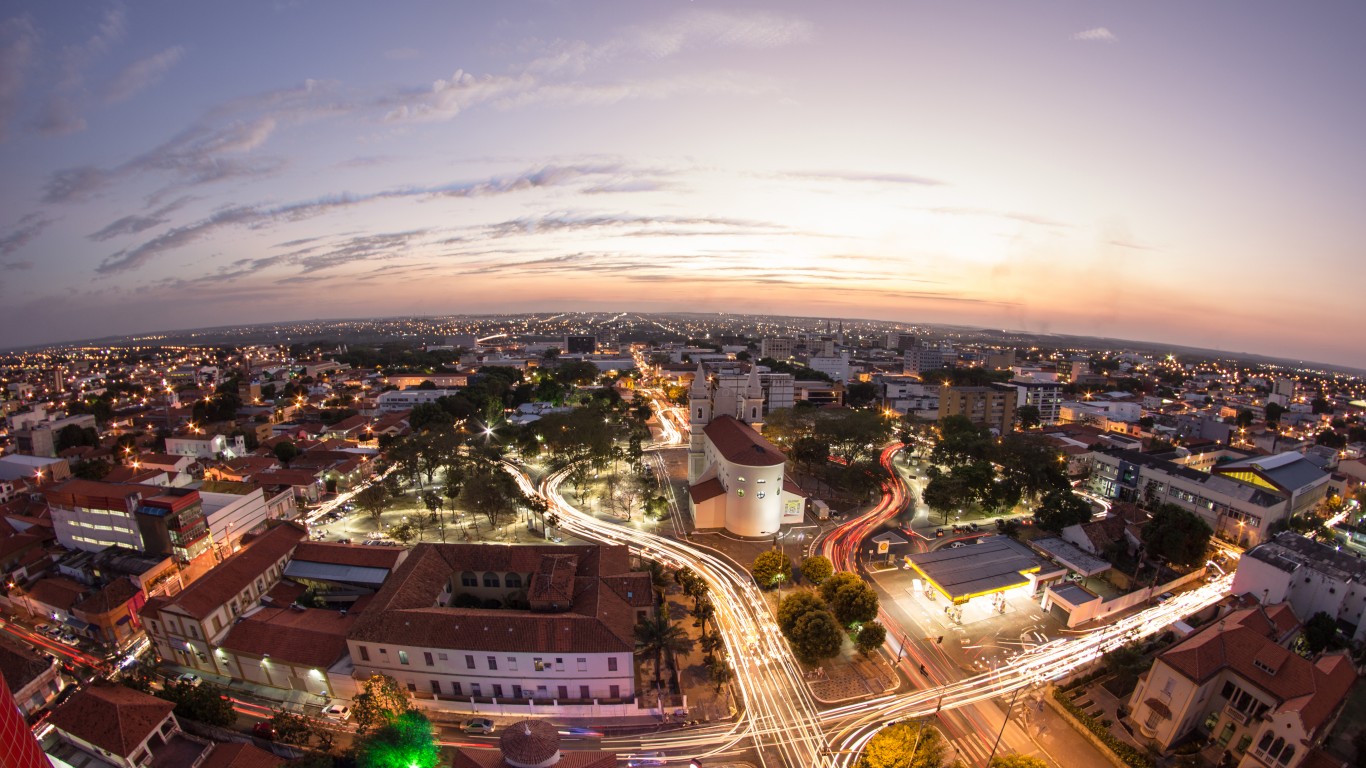
48. Teresina, Brazil
> Homicides per 100,000: 37.1
> 2017 homicides: 315
> Population: 850,198
This industrial city is situated in Brazil’s northeastern region, the country’s poorest. The region’s extreme poverty has contributed to Teresina having one of the highest homicide rates in the world. But the situation was a little less grim in 2017. Teresina’s ranking dropped from No. 20 in 2015 to No. 38 in 2016 and to No. 48 last year as the country began to dig out of its worst recession on record and returned to growth last year. Economic growth can improve public security as more people find work. Often, however, that improvement depends on where people live and how much access they have to jobs.
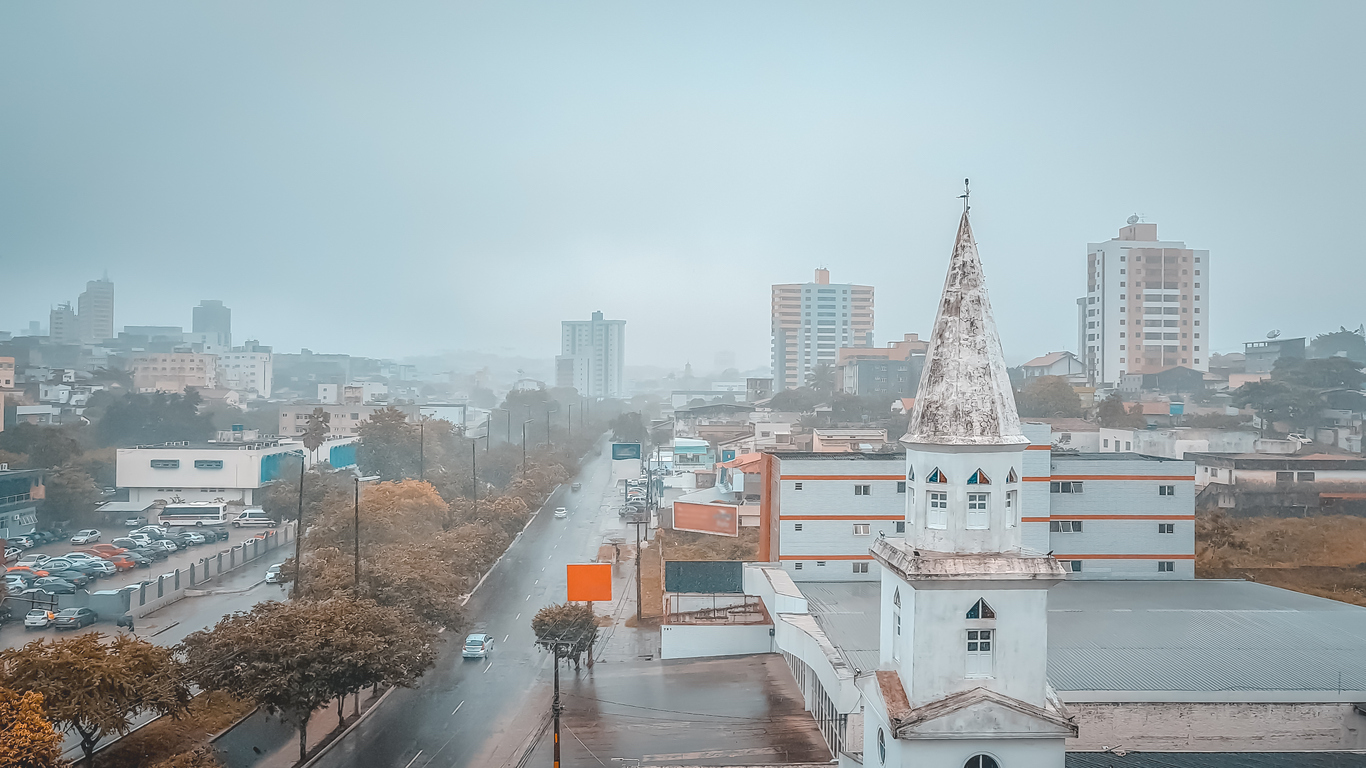
47. Campina Grande, Brazil
> Homicides per 100,000: 37.3
> 2017 homicides: 153
> Population: 410,332
One of the main technological and educational centers in Brazil returns to the list after a 2016 hiatus. Prior to that, Campina Grande ranked 40th and 30th in 2015 and 2014, respectively. An uptick in violent crime last year linked to drug gangs put the city back on the list, underscoring the often haphazard results of law enforcement efforts. Brazilian crime tends to wax and wane depending on where military assets are deployed to fight gang activity. Police have been most effective combating competing drug gangs in São Paulo and Rio de Janeiro, where crime has dropped significantly.
[in-text-ad-2]
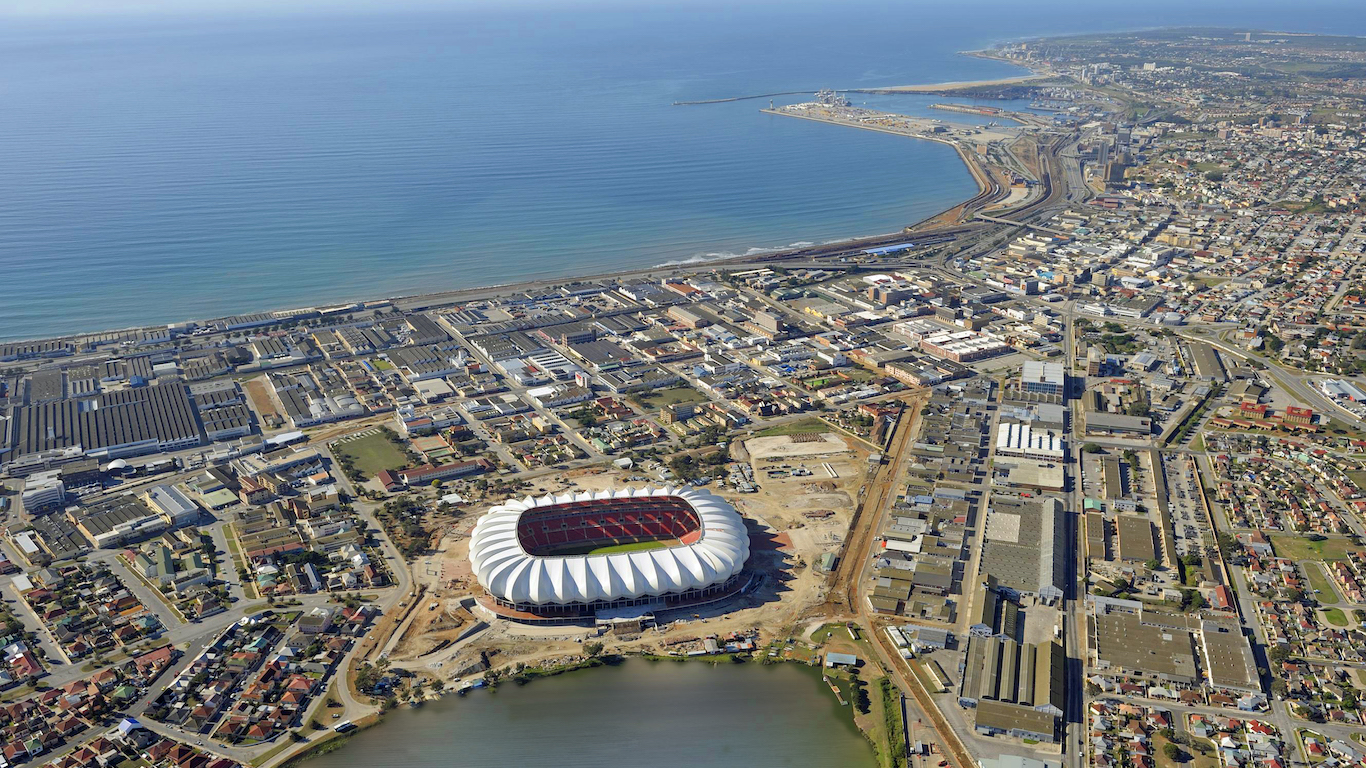
46. Nelson Mandela Bay, South Africa
> Homicides per 100,000: 37.5
> 2017 homicides: 474
> Population: 1,263,051
Though the homicide rate in Nelson Mandela Bay, which comprises the city of Port Elizabeth and surrounding area, declined for the third consecutive year, it remains one of the three most dangerous South African cities. This port municipality on the country’s southern coast, as well as the other South African cities on the list, is enduring gang violence and a general sense of lawlessness in some areas. Overall crime in South Africa declined last year, led by a reduction in sexual and other forms of physical assault. The murder rate, however, has increased.
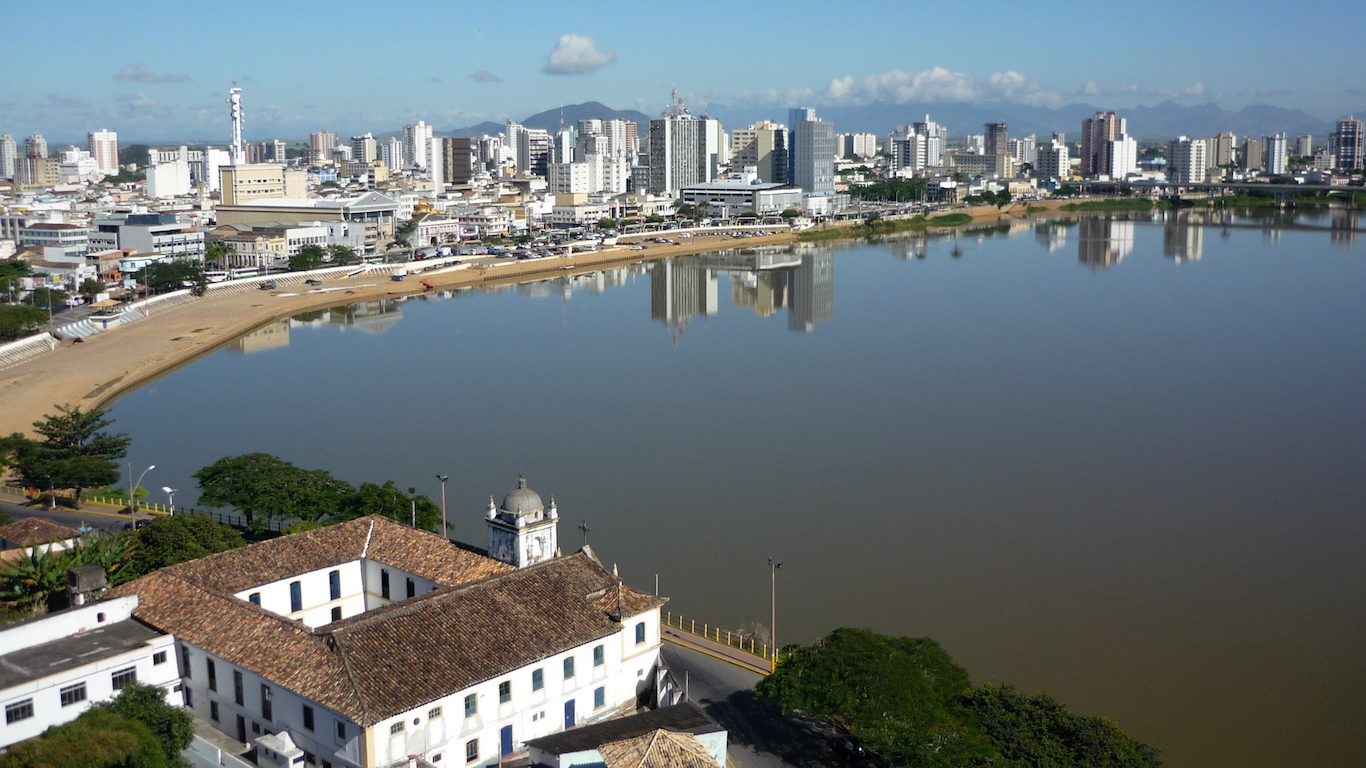
45. Campos dos Goytacazes, Brazil
> Homicides per 100,000: 37.5
> 2017 homicides: 184
> Population: 490,288
As the homicide rate declined significantly in this oil-rich region in Brazil’s southeast, the city’s rank also dropped to 45th from 19th. In 2016, there were 56.5 homicides per 100,000 city residents. Like elsewhere in Brazil, police and military actions can have an impact on drug gang-related crime — one of the main causes of homicides in the country. Crime activity largely depends on the prevalence of rival gangs, security operations, and level of poverty and unemployment.
[in-text-ad]
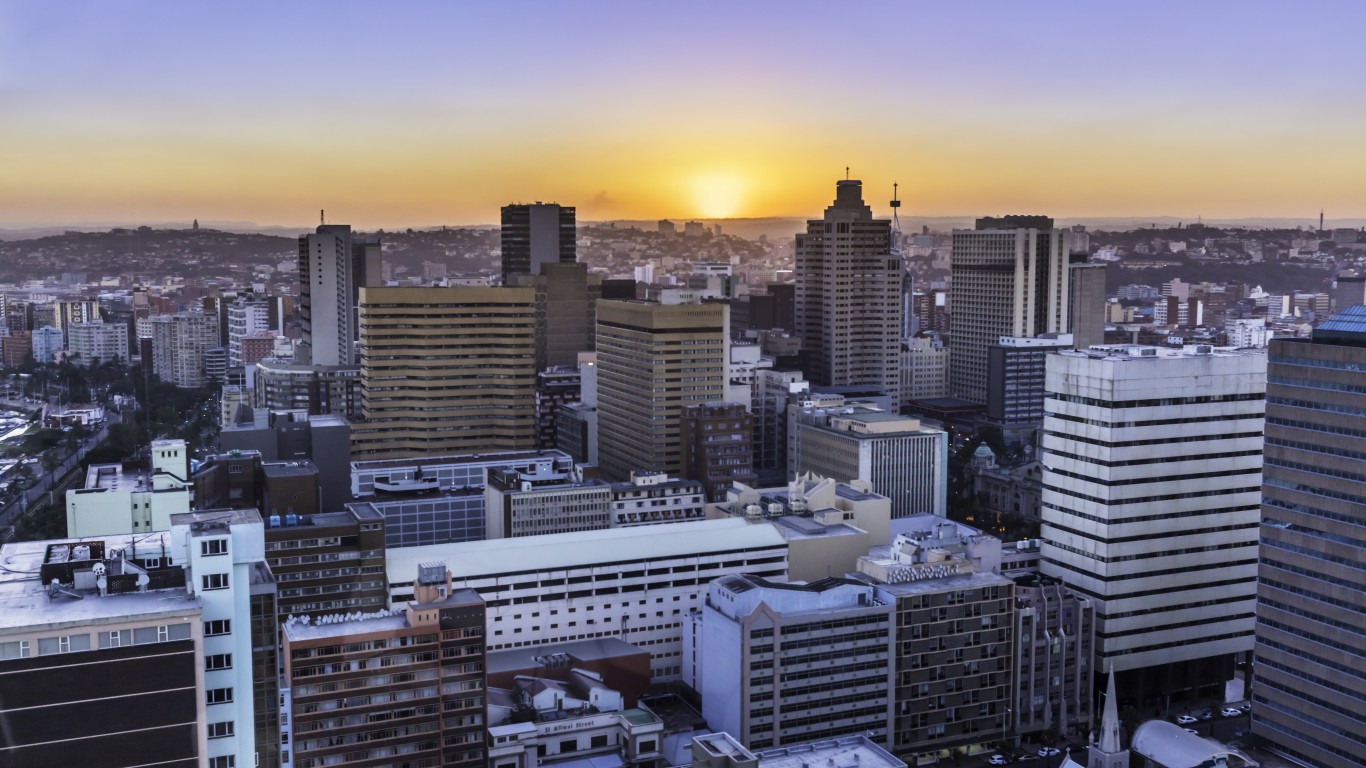
44. Durban, South Africa
> Homicides per 100,000: 38.1
> 2017 homicides: 1,396
> Population: 3,661,911
This city on the eastern coast of South Africa experienced an increase in its homicide rate last year after just barely making the list at No. 50 in 2016. Like in South Africa’s other bigger cities, the prevalence of gang activity and other types of violent crime can lead to murder. South Africa has one of the highest rates of violence and sexual assault against women, and, in Durban, kidnappings are disturbingly common.
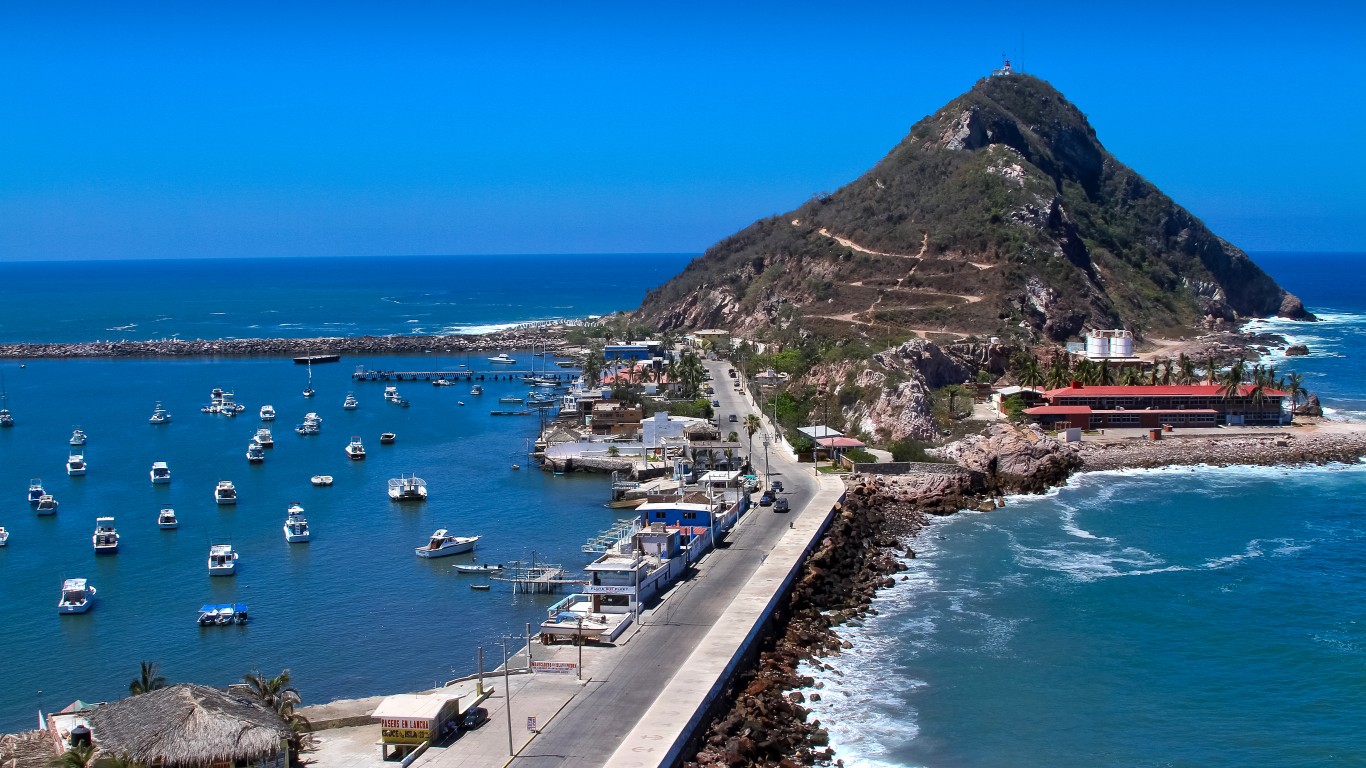
43. Mazatlán, Mexico
> Homicides per 100,000: 39.3
> 2017 homicides: 192
> Population: 488,281
This coastal western Mexican city in Sinaloa state has long been a tourist destination despite its location near the home base of the country’s brutal Sinaloa Cartel. Mazatlan had largely remained insulated from bloodletting in the countryside, but the city first appeared on Seguridad, Justicia y Paz’s list in 2016, ranking as the 27th most dangerous city with 48.8 homicides per 100,000 residents. That same year, two Australian surfers were murdered in a botched robbery near Mazatlan that garnered global attention. Efforts by Mexican security forces to step up patrols and enforcement in the city may have helped lower the murder rate last year, but Mazatlan remained on the list for 2017. The U.S. State Department advises to avoid travel to Sinaloa and five other Mexican states.
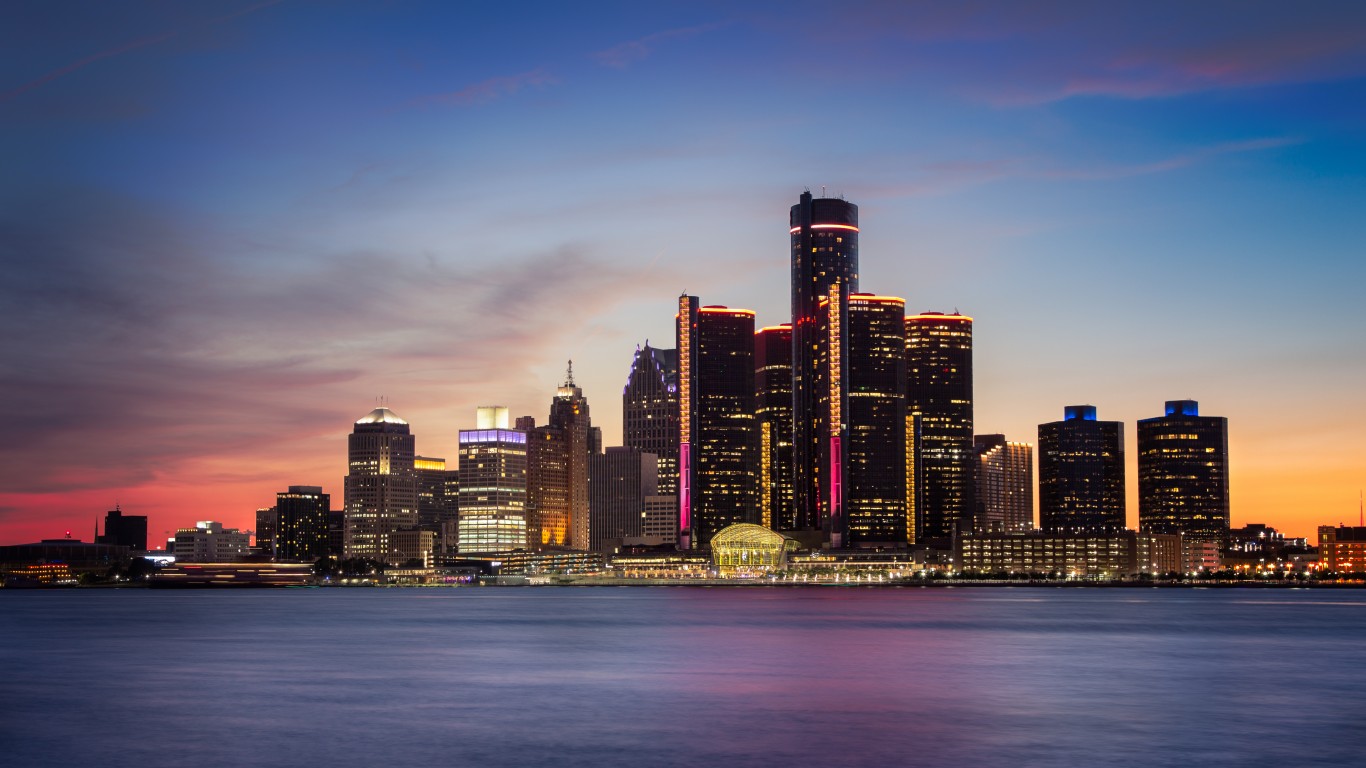
42. Detroit, United States
> Homicides per 100,000: 39.7
> 2017 homicides: 267
> Population: 672,795
Detroit is one of four U.S. cities that routinely make it on the list of the world’s most murderous cities, but for the third year in a row, Motor City’s homicide rate has declined. Local authorities credit the lower murder rate to the city’s five-year-old Ceasefire Detroit initiative aimed at dismantling local gangs and establishing youth-outreach programs in coordination with the U.S. Department of Justice. The FBI considers Detroit to be the country’s most dangerous when factoring all violent crime, but its homicide rate is the lowest of the four U.S. cities that made the 2017 list.
[in-text-ad-2]
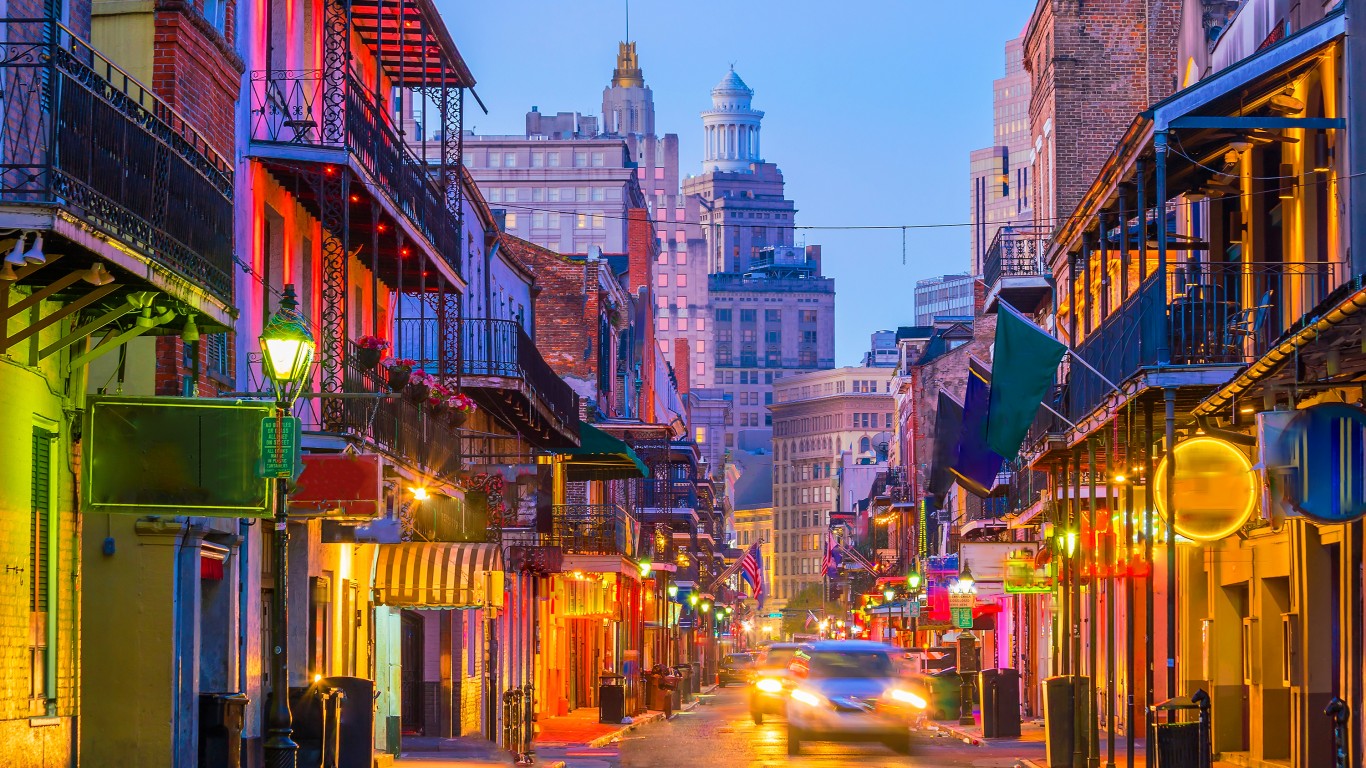
41. New Orleans, United States
> Homicides per 100,000: 40.1
> 2017 homicides: 157
> Population: 391,495
New Orleans was forever changed by Hurricane Katrina, which struck the city in 2005 and radically shook up its demographics. Not only has the Big Easy nearly fully recovered from one of the worst and costliest storms in U.S. history, but also for the fifth year in a row it has been able to reduce its homicide rate from about 45 killings per 100,000 residents in 2013 to about 40 per 100,000 last year. A Washington Post analysis found that in many of the city’s areas with high murder rates, arrest rates are relatively low and many murders go unsolved.
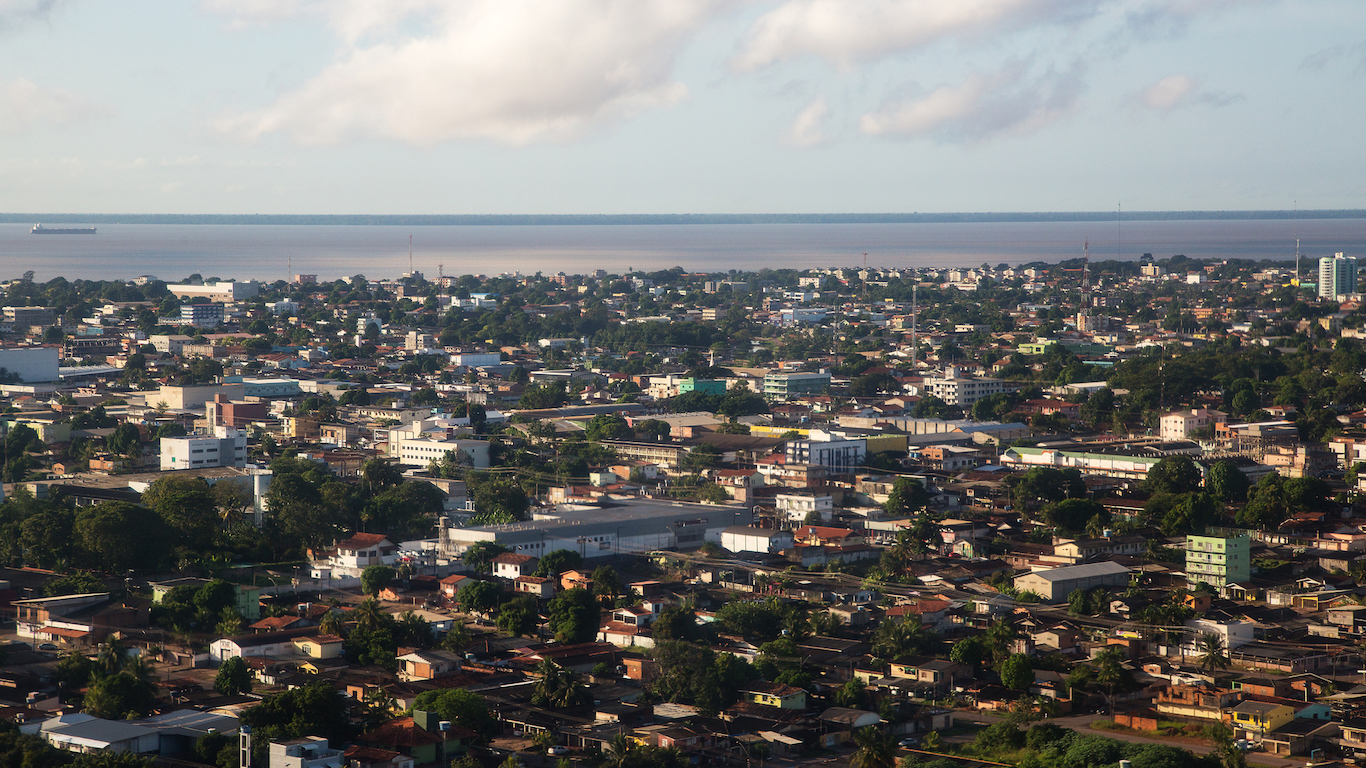
40. Macapá, Brazil
> Homicides per 100,000: 40.2
> 2017 homicides: 191
> Population: 474,706
This mining-and-lumber city situated on the Amazon River delta in northern Brazil is the region’s economic powerhouse. In addition to street-level crime plaguing much of the country, Macapá (as well as nearby Belém) faces a problem of violent, heavily armed river pirates, who raid vessels of gold, iron, lumber, and other valuable goods.
[in-text-ad]
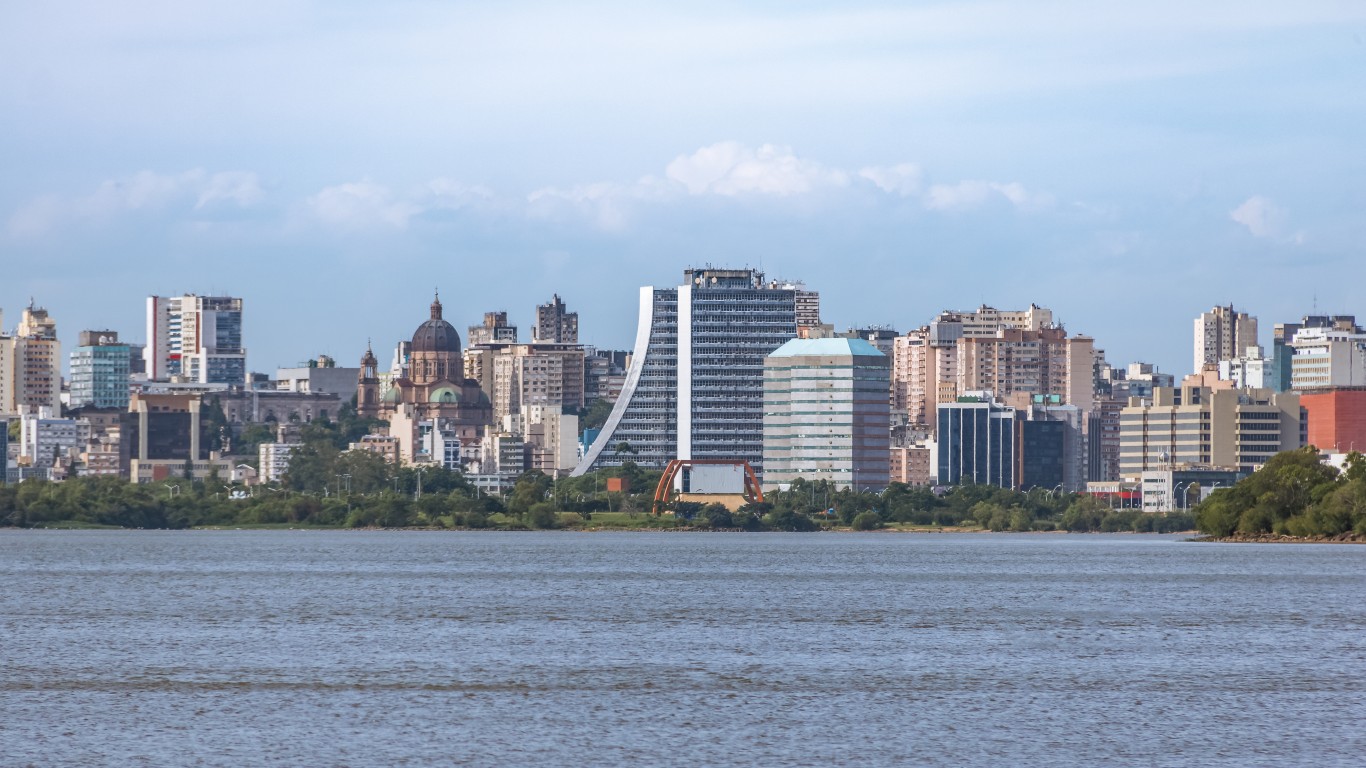
39. Porto Alegre, Brazil
> Homicides per 100,000: 41.0
> 2017 homicides: 1,748
> Population: 4,268,083
Following a relatively low rate of homicides in 2016, this port city in southern Brazil returned to the list last year. With its diverse nightlife, Porto Alegre attracts a significant amount of drug-related criminal activity and the ensuing gang-related fighting over turf. The city’s absence from the list in 2016 seems to be a statistical blip. In the previous two years Porto Alegre ranked No. 43 in 2015 and No. 37 in 2014.
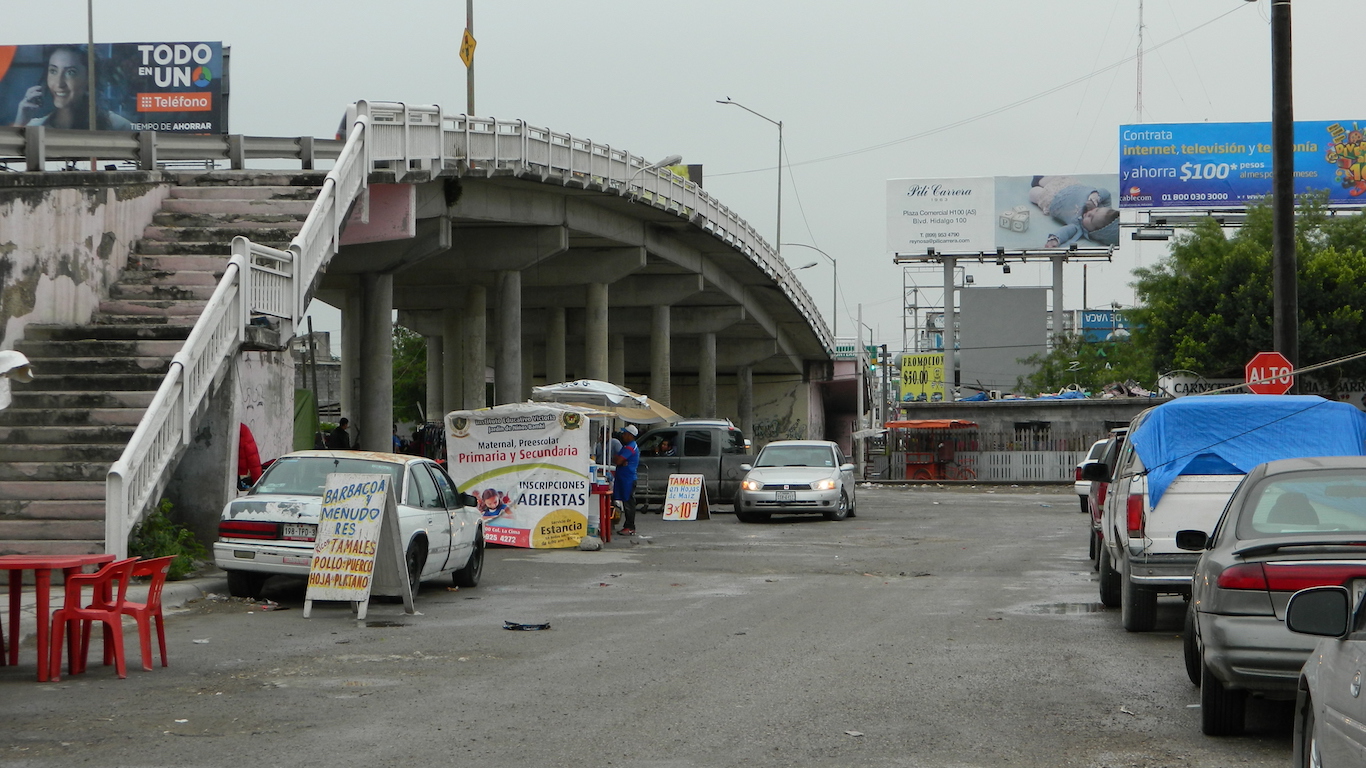
38. Reynosa, Mexico
> Homicides per 100,000: 42.0
> 2017 homicides: 294
> Population: 701,525
This northeastern Mexican border city resides in Tamaulipas state, which is home to the Gulf Cartel, one of Mexico’s oldest criminal organizations. Now it seems the violence is hitting this city just across the Rio Grande from McAllen, Texas. This is the first time Reynosa has appeared on the list since Seguridad, Justicia y Paz began tracking annual homicide rates in 2013. Mexican law enforcement began noticing an uptick in violence in Reynosa in the spring of last year, after the April 22 killing of Gulf Cartel faction leader Juan Manuel Loisa Salinas, aka Comandante Toro, by local police. Loisa Salinas’s death seems to have sparked a wave of killings in the city amid shootouts between different factions of the Gulf Cartel and with police.
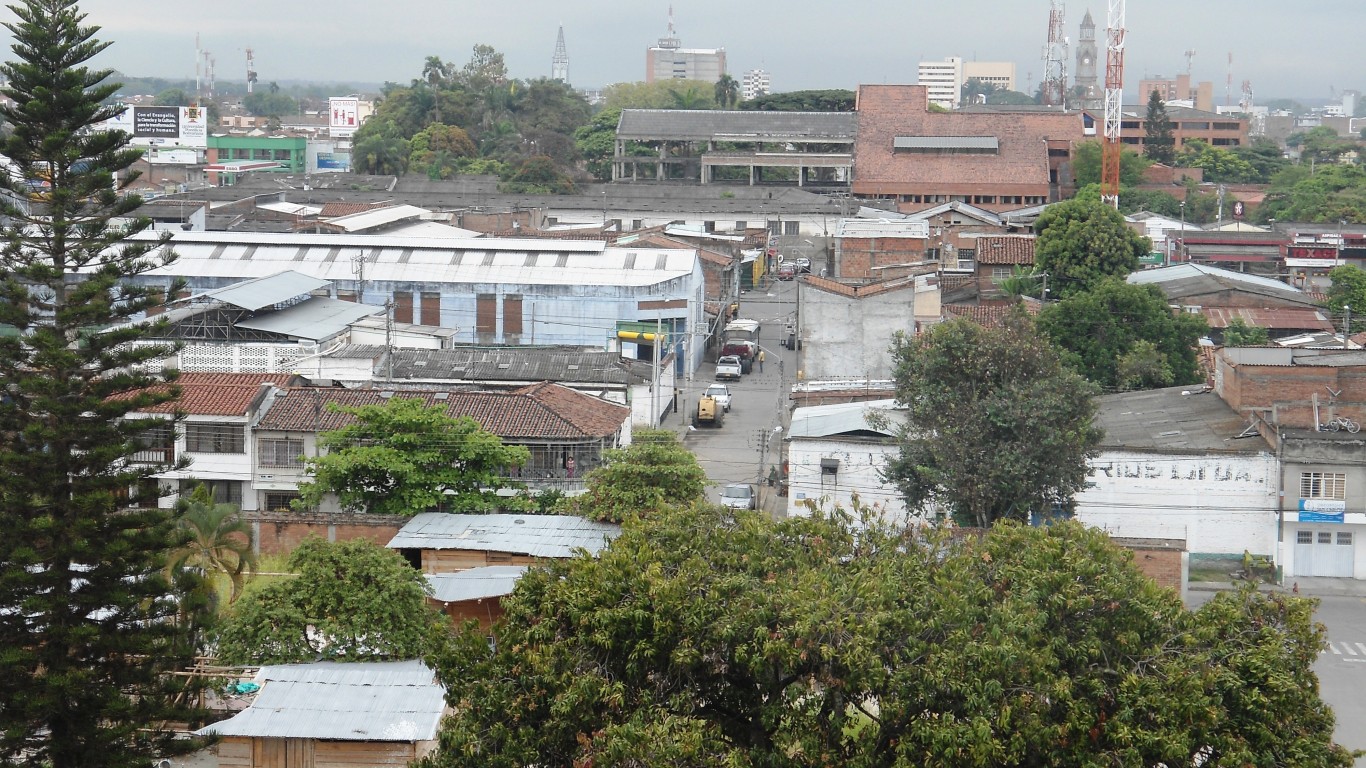
37. Palmira, Colombia
> Homicides per 100,000: 46.7
> 2017 homicides: 144
> Population: 308,669
This western Colombian city dropped in ranking — from 31st last year. The decline in murder rate follows a peace deal between the government and FARC rebels that helped calm decades of civil conflict. Heightened security measures and community interventions in one of the country’s most troubled regions helped reduce the homicide rate in 2016. That progress continued and gained traction after the November 2016 peace deal.
[in-text-ad-2]
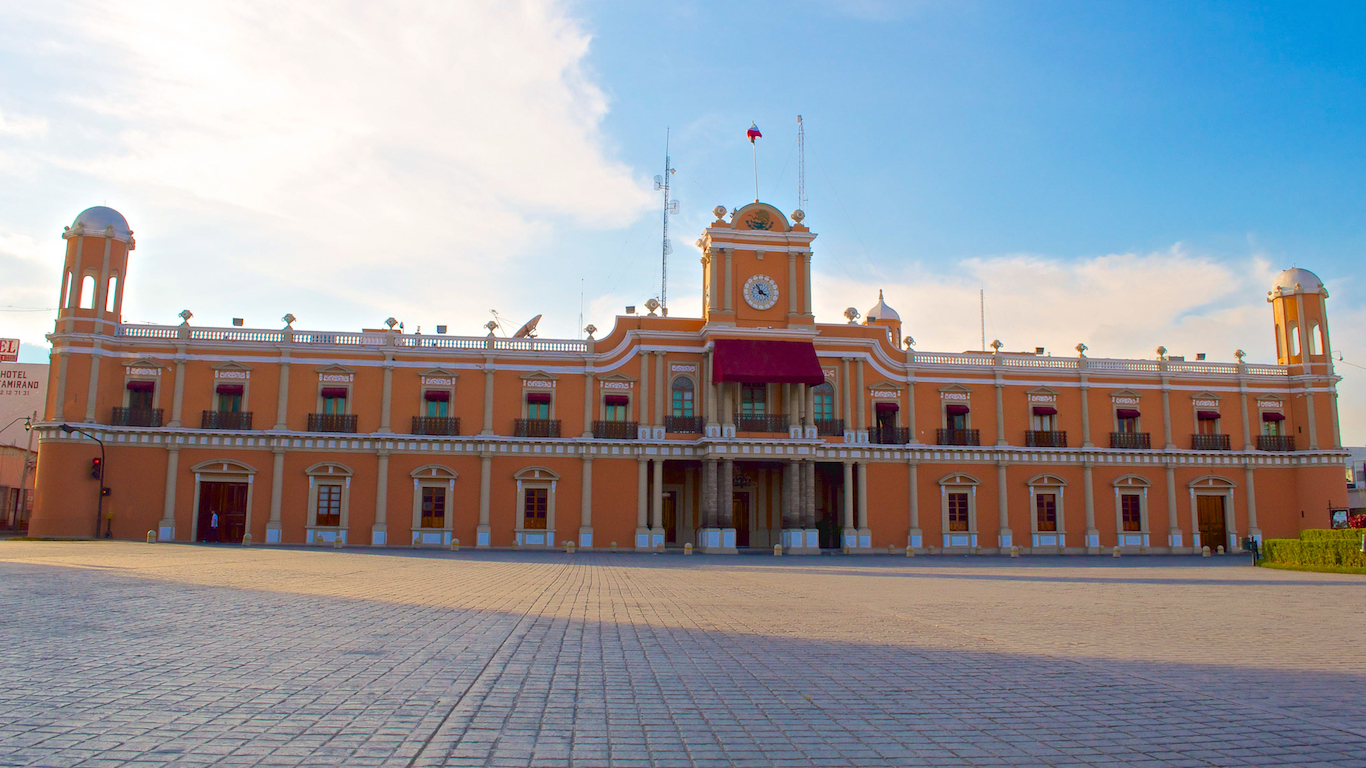
36. Tepic, Mexico
> Homicides per 100,000: 47.1
> 2017 homicides: 237
> Population: 503,330
Like the Mexican border city of Reynosa, Tepic appeared on the list of the 50 most dangerous cities for the first time last year since Seguridad, Justicia y Paz began tracking homicide rates for its annual report in 2013. Late last year, the U.S. Consulate in Guadalajara issued a travel warning after noticing an increase in violence and cartel activity in western Nayarit state, particularly around the cities of San Blas and Tepic. Last year, Nayarit’s state prosecutor falsely claimed to have made great strides against violent crime. The prosecutor, Edgar Veytia, was charged and indicted on alleged drug trafficking conspiracy charges and extradited to the United States for trial.
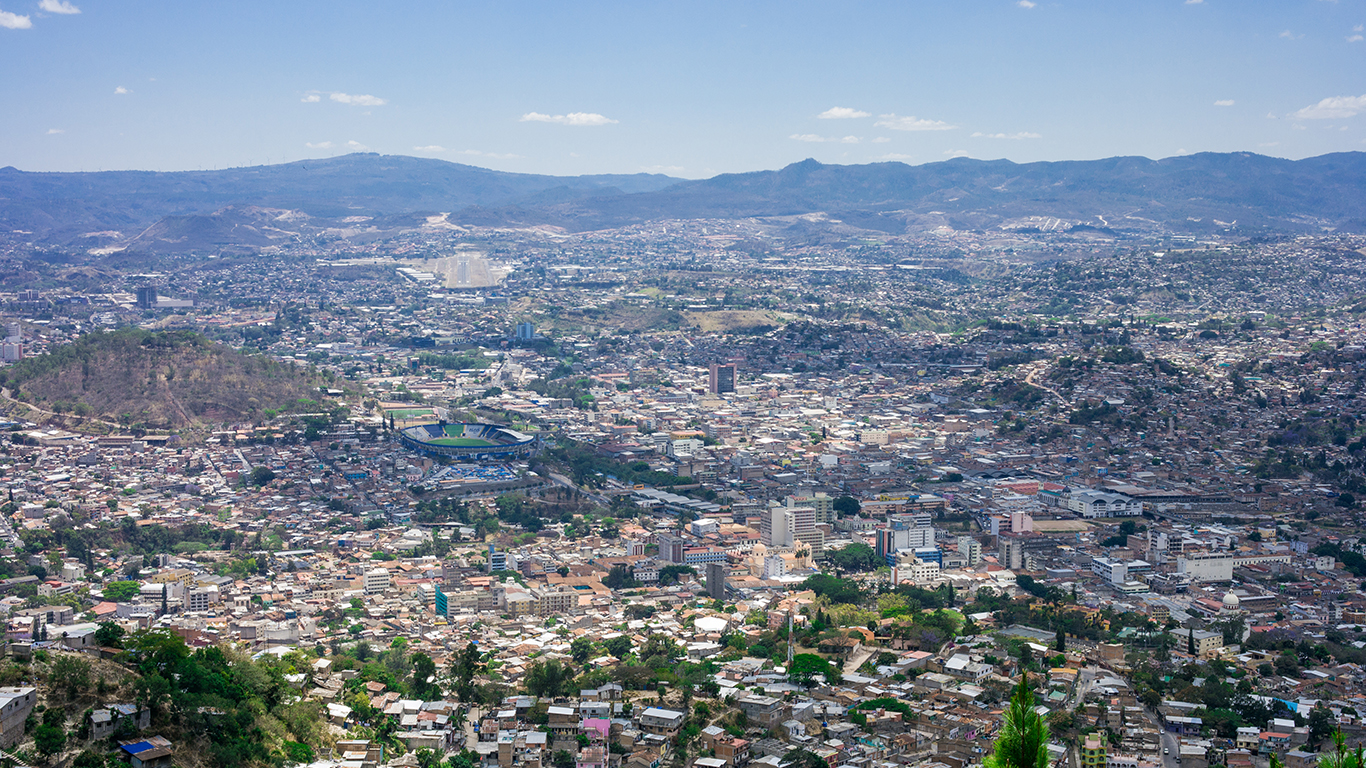
35. Distrito Central, Honduras
> Homicides per 100,000: 48.0
> 2017 homicides: 588
> Population: 1,224,897
Gang violence in Honduras has led to waves of U.S.-bound migrants and refugees in recent years as the tiny nation (population 9 million) is home to two of the world’s most dangerous cities. But the homicide rate in Distrito Central, which includes the capital Tegucigalpa and its sister city Comayagüela, declined significantly in 2017 to 48 homicides per 100,000 residents. In 2016, there were 85 homicides per 100,000 residents, when Distrito Central ranked 4th on the list. The drop in homicides has been attributed to an aggressive and coordinated assault on gangs and drug trafficking by national police and the military.
[in-text-ad]
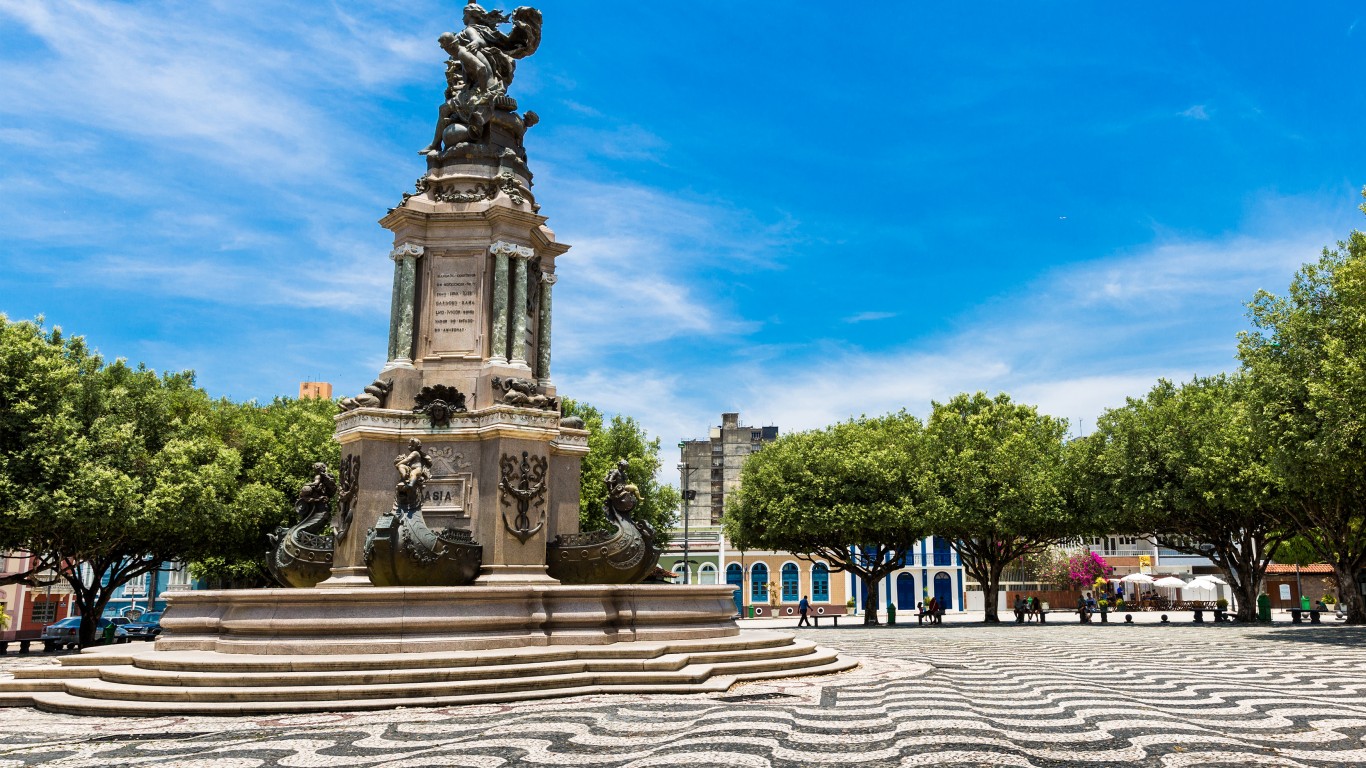
34. Manaus, Brazil
> Homicides per 100,000: 48.1
> 2017 homicides: 1,024
> Population: 2,130,264
The violent drug trade has thrived in the most populous city in the Amazon rainforest, whose ranking on the list rose from No. 46 last year. Manaus is home to a free trade zone and one of the country’s busiest ports, but its proximity to cocaine-producing areas of Colombia and Peru makes it an enticing conduit for distribution to other parts of the country and to Europe. Drug trafficking has made the city a hotspot for gang-related activity.
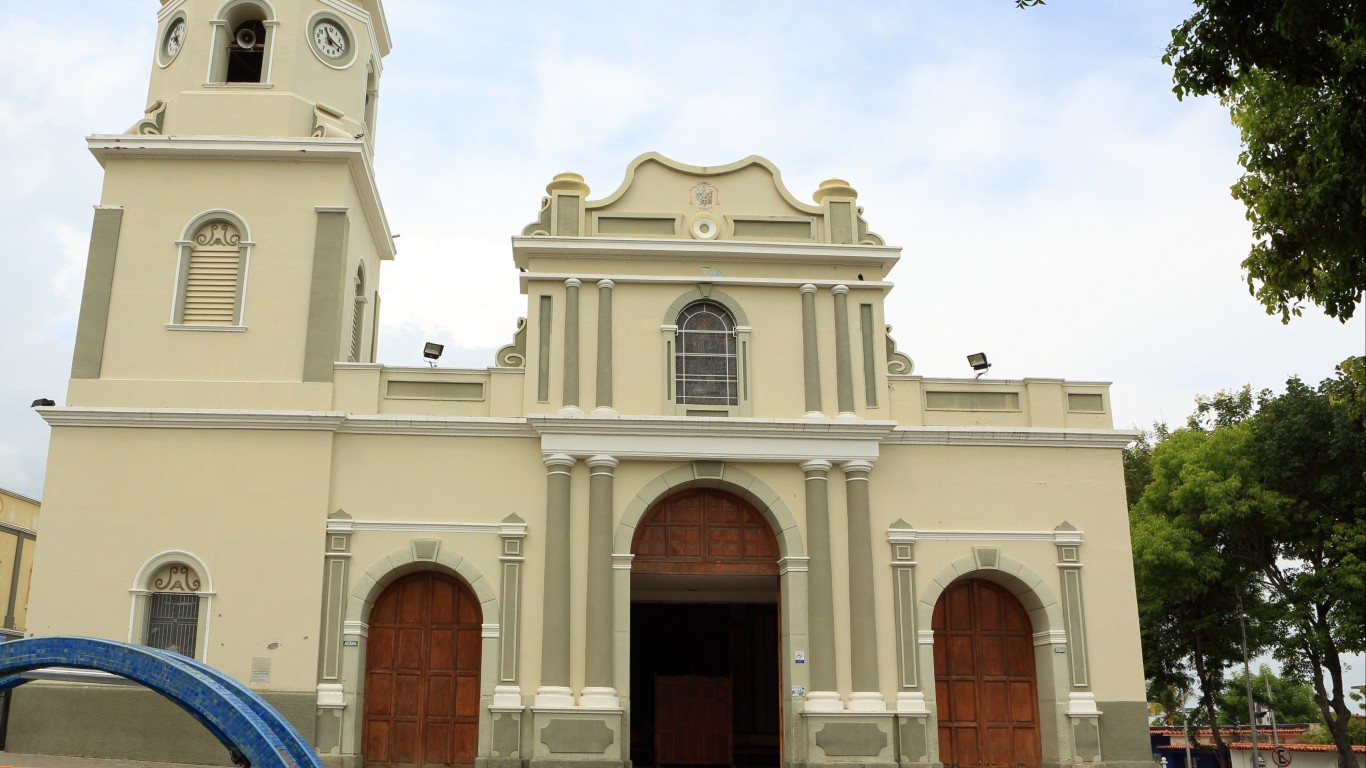
33. Barquisimeto, Venezuela
> Homicides per 100,000: 48.2
> 2017 homicides: 644
> Population: 1,335,348
Venezuela’s fourth most populous city is its fifth bloodiest. The homicide rate in this center for commercial transport declineed last year even as conditions in the country worsened amid food shortages, political unrest, and a national violent crime epidemic. Many of the country’s people are caught between groups loyal to President Nicolás Maduro’s strongman government and the criminal gangs emboldened by the country’s chaos.
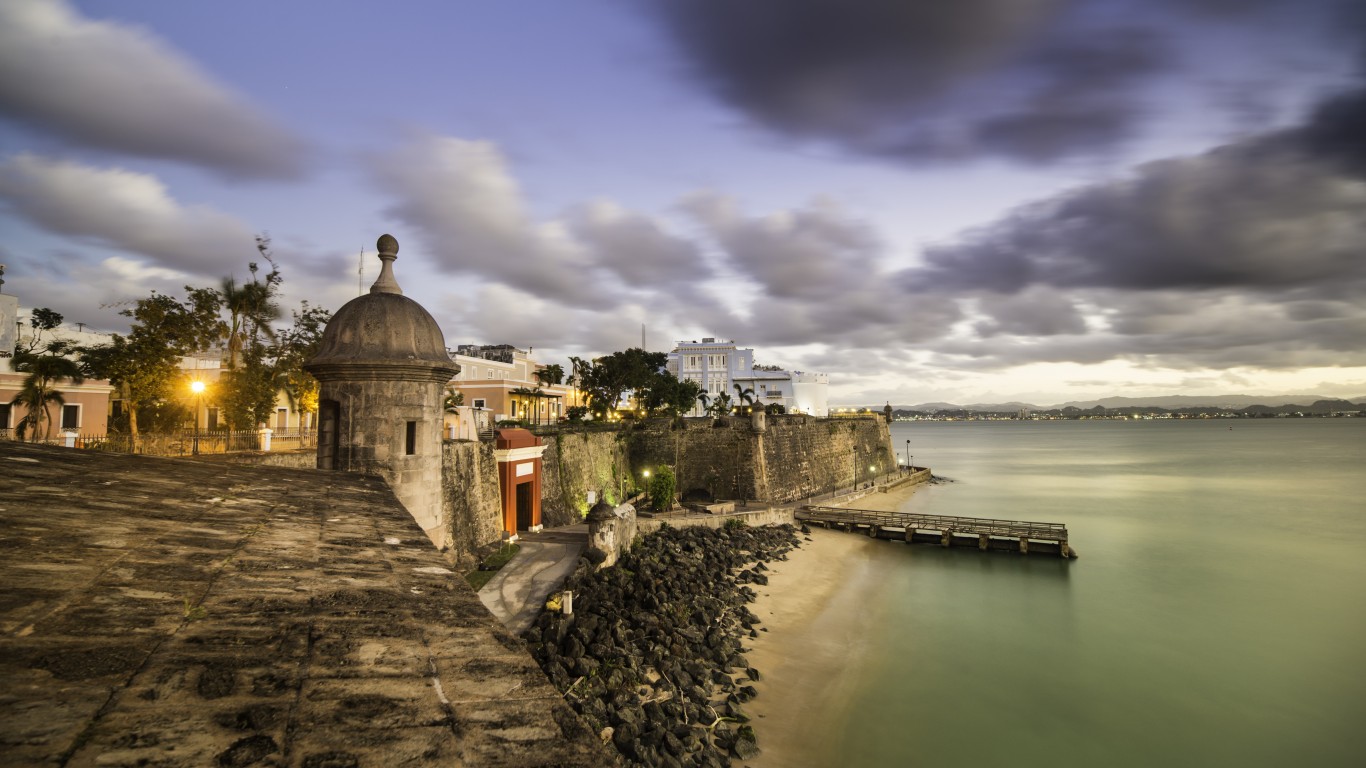
32. San Juan, Puerto Rico
> Homicides per 100,000: 48.7
> 2017 homicides: 169
> Population: 347,052
This U.S. commonwealth has suffered a crippling economic crisis and is still cleaning up after Hurricane Maria ravaged the island in September 2017. Poor economic conditions and the effects of the storm pushed the number of violent crimes and homicides in San Juan higher, placing the capital city on the list for the first time since 2013. Police officer became overwhelmed by the chaos following the hurricane, and amid the struggle to maintain law and order there was a spike in murders in the last three months of 2017. The higher rate of killings has continued, which means Puerto Rico may show up again on the 2018 list.
[in-text-ad-2]
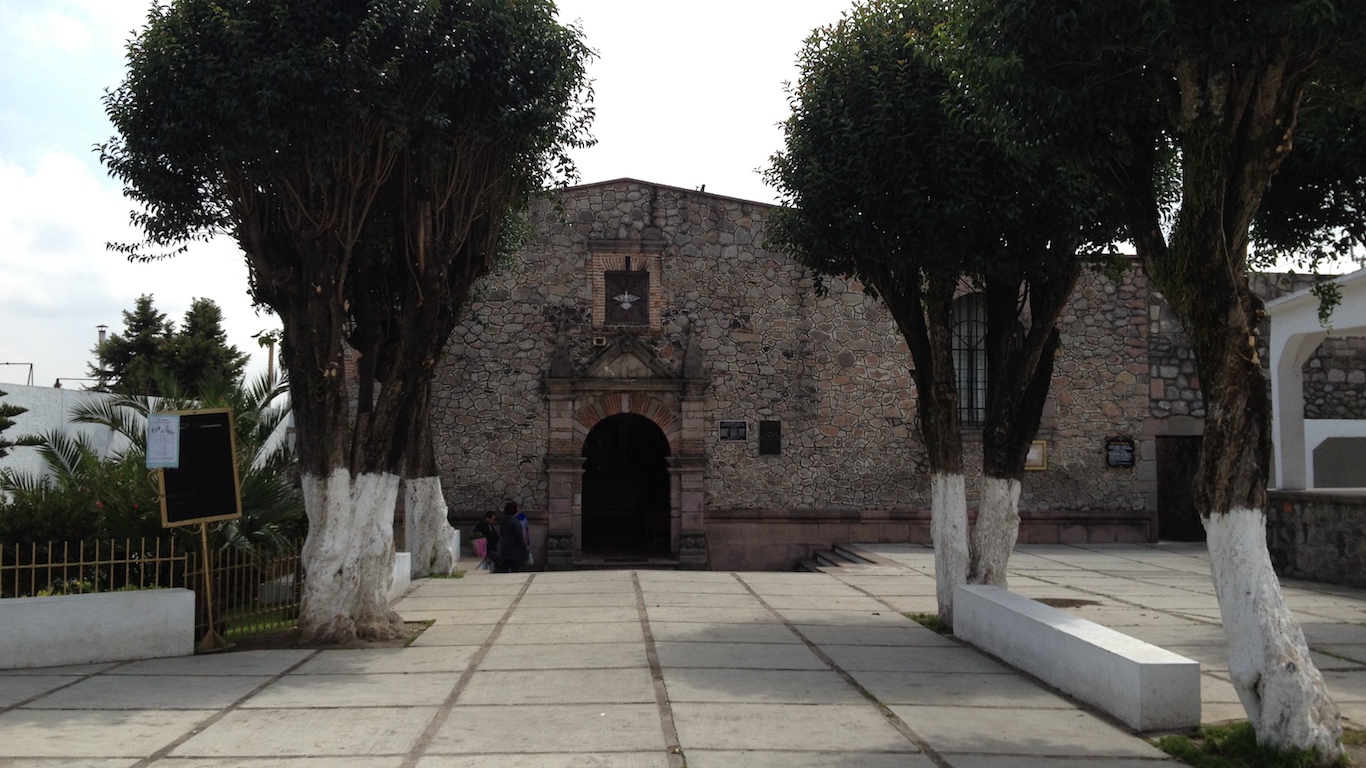
31. Obregón, Mexico
> Homicides per 100,000: 49.0
> 2017 homicides: 166
> Population: 339,000
The homicide rate in this northern Mexican city has increased over the past two years as drug cartel activity and other crimes has made Obregón a more dangerous place. The U.S. State Department has maintained a travel warning for Sonora state for the past three years, warning against non-essential travel within Obregón and recommends to stay on main roads during daylight hours throughout the state.
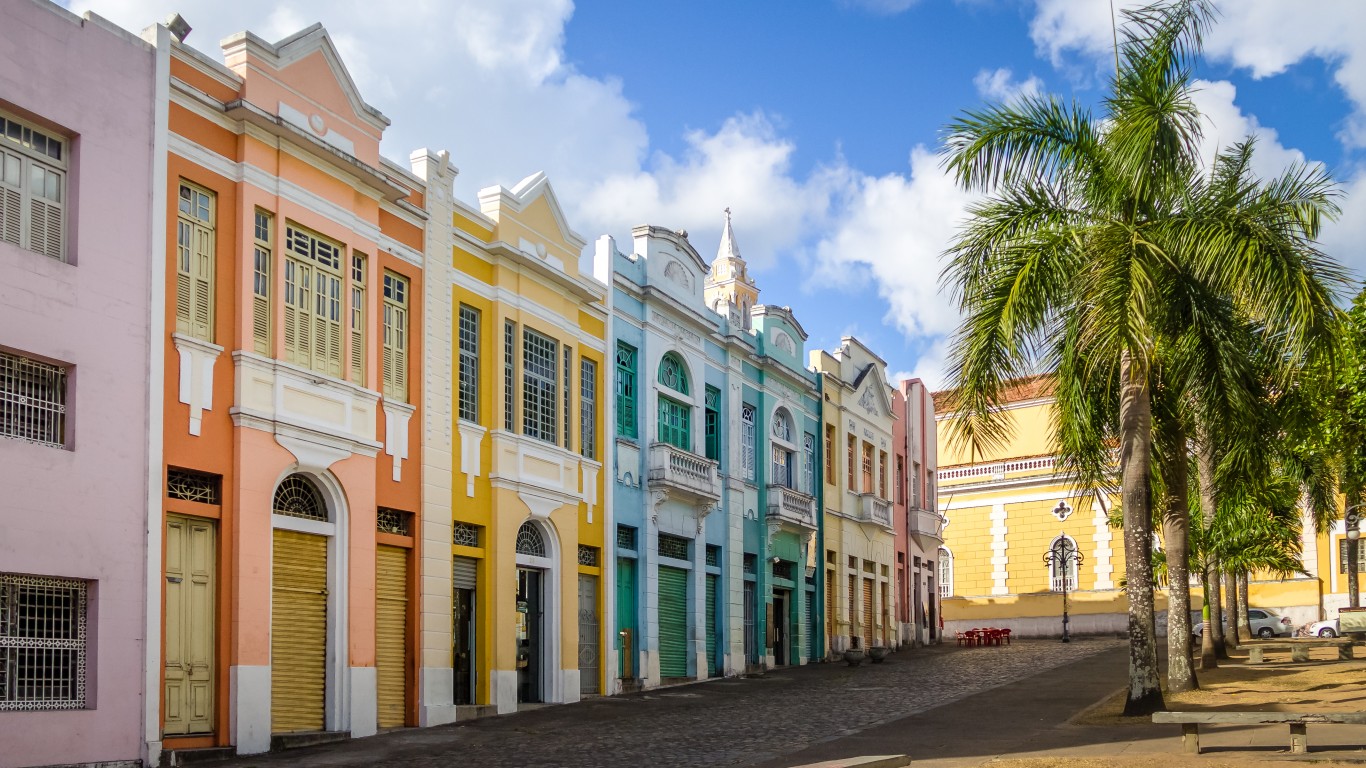
30. João Pessoa, Brazil
> Homicides per 100,000: 49.2
> 2017 homicides: 554
> Population: 1,126,613
João Pessoa enjoys the distinction of being the easternmost city in the western hemisphere, situated at the tip of where Brazil juts out into the Atlantic Ocean. In recent years, the city’s homicide rate has fallen, gradually pushing the city’s ranking upward from No. 4 in 2014 to No. 30 last year. The city has likely benefited from a study its crime patterns. This type of data was used by law enforcement to identify areas of the city where crime is more rampant.
[in-text-ad]
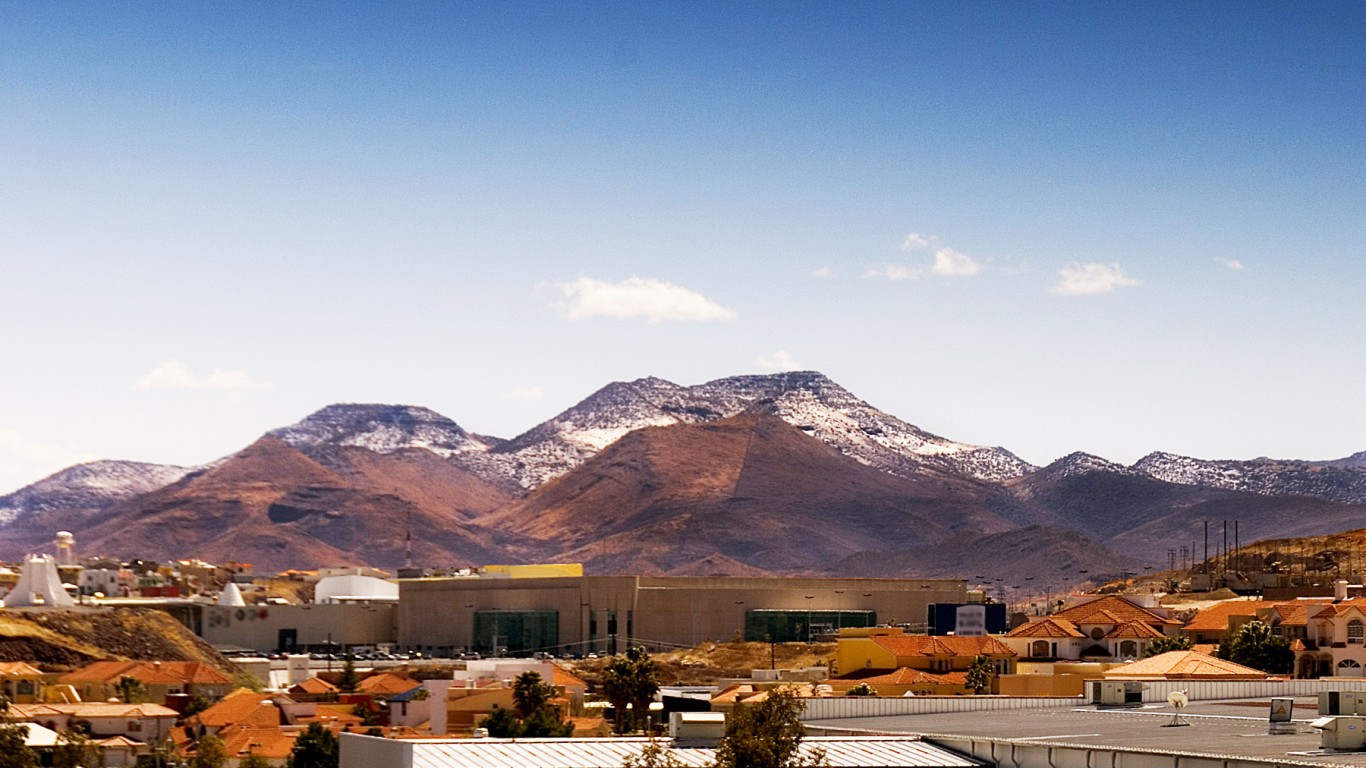
29. Chihuahua, Mexico
> Homicides per 100,000: 49.5
> 2017 homicides: 460
> Population: 929,884
In March of last year, prominent Mexican investigative journalist Miroslava Breach Velducea was gunned down in cold blood in Chihuahua. A note found at the scene indicated that a local organized crime boss was behind the murder, which also shined a spotlight on the uptick in violence in the eponymous state capital. Indeed, the homicide rate in the city increased in 2017, pushing its ranking up the list from 40th in the previous year. While gun-related murders in the state are still much lower than they were in the 2010 to 2012 period, they have been edging upward since 2013, especially among low-level dealers of heroin and methamphetamine.
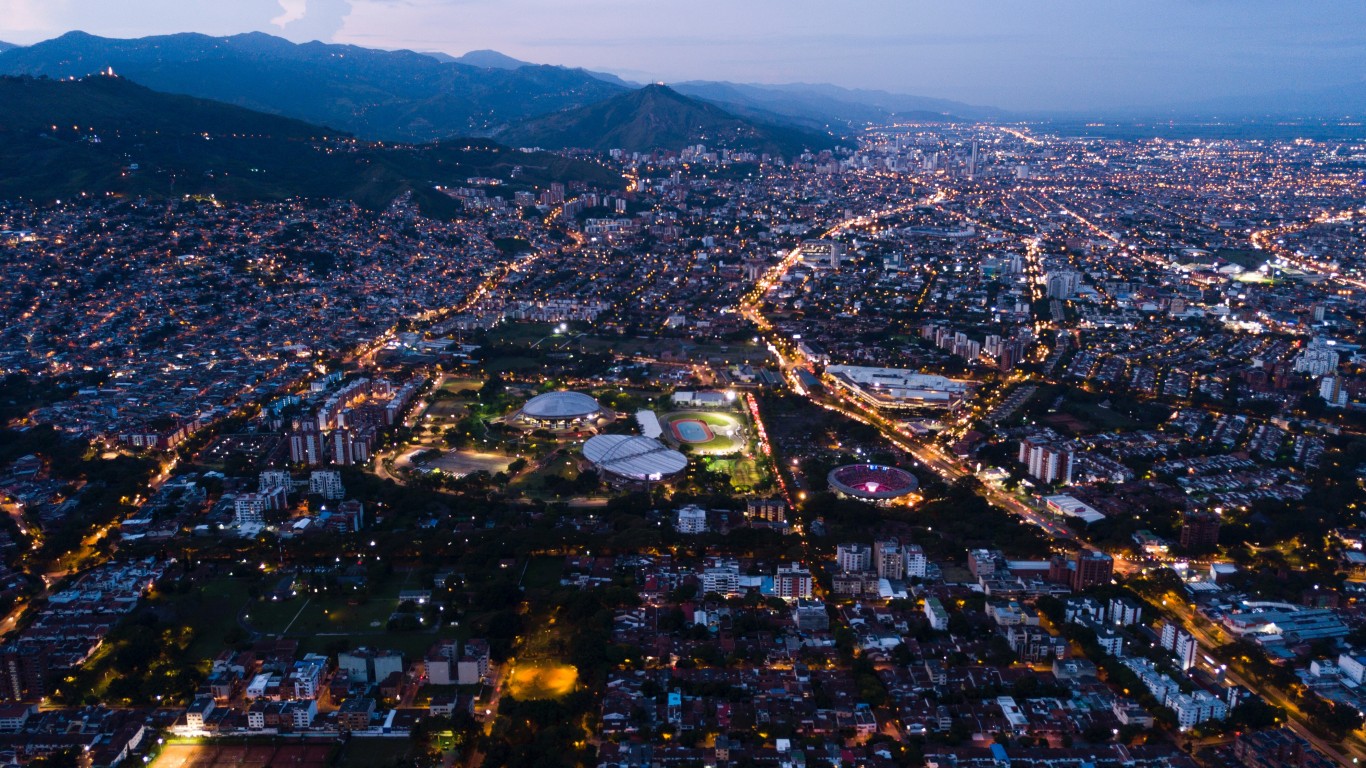
28. Cali, Colombia
> Homicides per 100,000: 49.6
> 2017 homicides: 1,261
> Population: 2,542,876
Once brutalized by the notorious Cali Cartel, this southwestern Colombia city is a safer place these days. Cali’s ranking dropped from 21st in 2016 thanks to heightened security operations and the November 2016 peace deal between the government and FARC rebels that ended 52 years of civil conflict. The number of homicides per 100,000 has dropped from 66.4 to under 50 in less than four years. However the city remains the country’s most dangerous in part because of dissident rebels operating in the region.
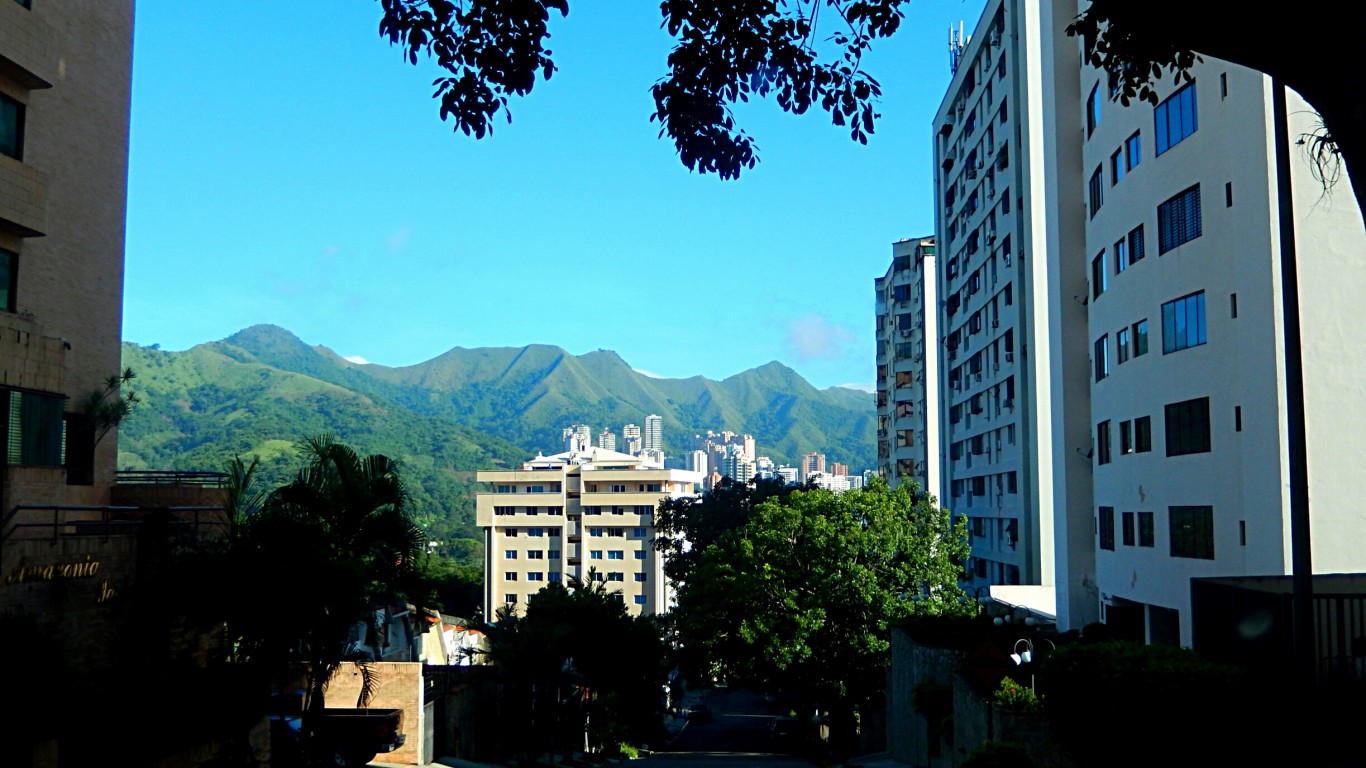
27. Valencia, Venezuela
> Homicides per 100,000: 49.7
> 2017 homicides: 784
> Population: 1,576,071
This economic hub in the country’s northwest is both Venezuela’s third largest and third most dangerous city. Like in the country’s other three cities on the list, the homicide rate declined last year, but the country still remains among the most dangerous almost anywhere you go. As the country’s deep economic crisis shows little signs of improving, especially as President Nicolás Maduro’s regime has contributed to rising poverty, Venezuela will likely remain among the world’s most dangerous countries for years to come.
[in-text-ad-2]
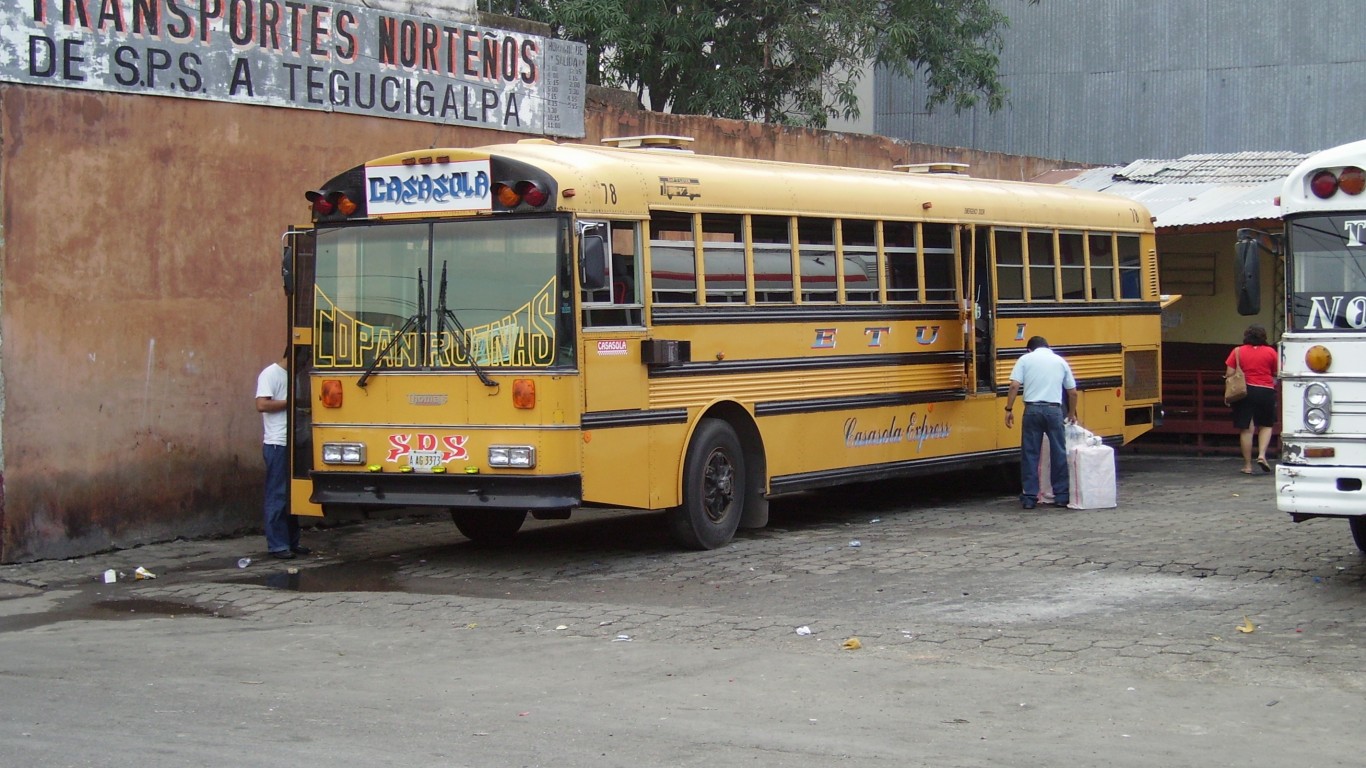
26. San Pedro Sula, Honduras
> Homicides per 100,000: 51.2
> 2017 homicides: 392
> Population: 765,864
Like Honduras’ capital city of Tegucigalpa, San Pedro Sula in the north of this tiny Central American country reported a drop in homicides amid an aggressive crackdown by authorities on gangs and drug traffickers. U.S.-funded programs to help community leaders confront crime in their areas appear to have also helped. As a result, San Pedro Sula’s ranking dropped to No. 26 from No. 3 in 2016 and No. 1 in both 2014 and 2013. The country remains one of the world’s most dangerous, but a little less so these days.
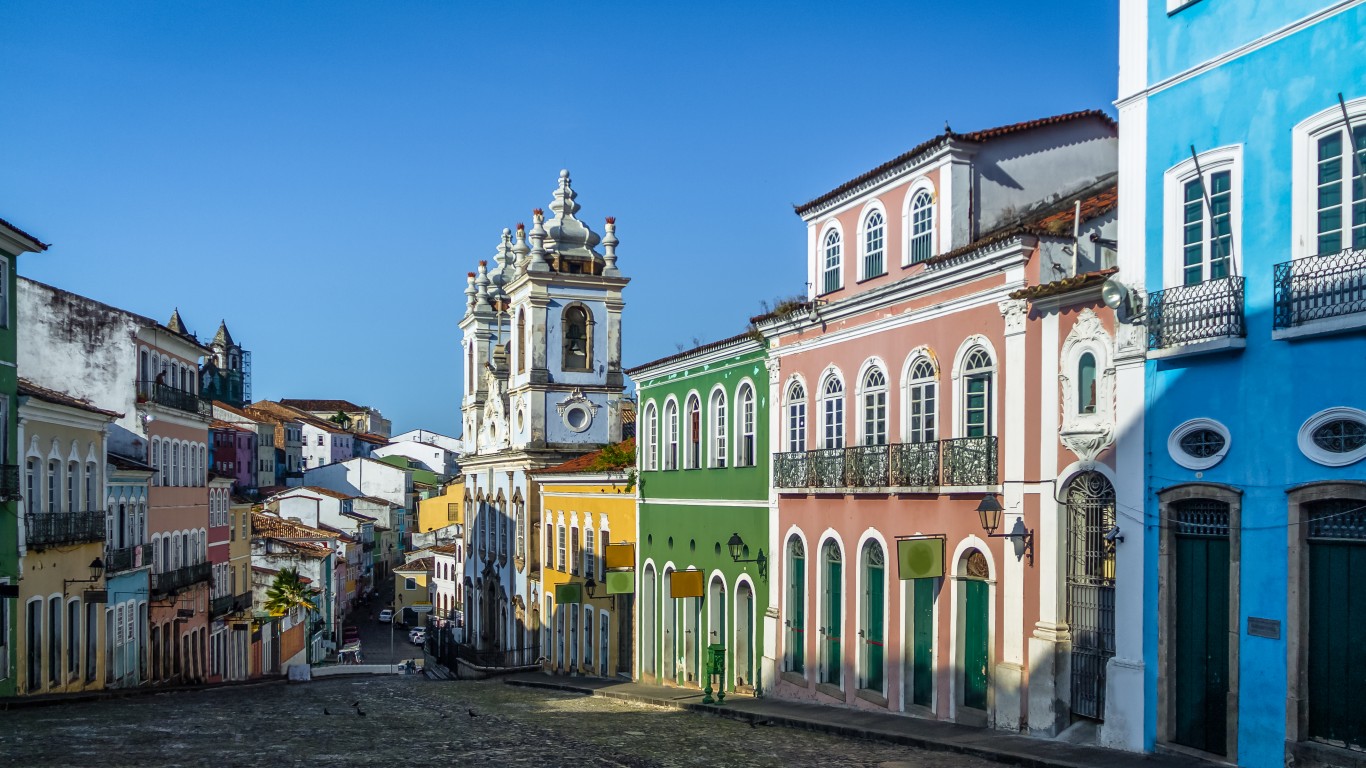
25. Salvador, Brazil
> Homicides per 100,000: 51.6
> 2017 homicides: 2,071
> Population: 4,015,205
Salvador has always been a historically, economically, and culturally important port city situated on the country’s northeastern coast. But like other Brazilian cities, the economic disparity between the small number of wealthy elites and the larger number of poor residents has led to high rates of violent crime and drug gang-related activity. Unlike Rio de Janeiro and São Paulo, Salvador has not benefited from some of the policing strategies that have pacified the homicide rates in the country’s two most well-known cities (but also have raised concerns of excessive force by police officers). While Salvador still ranks in the top 25 dangerous cities, the security situation has improved since 2015, when Salvador ranked 14th with 54.3 homicides per 100,000 residents.
[in-text-ad]
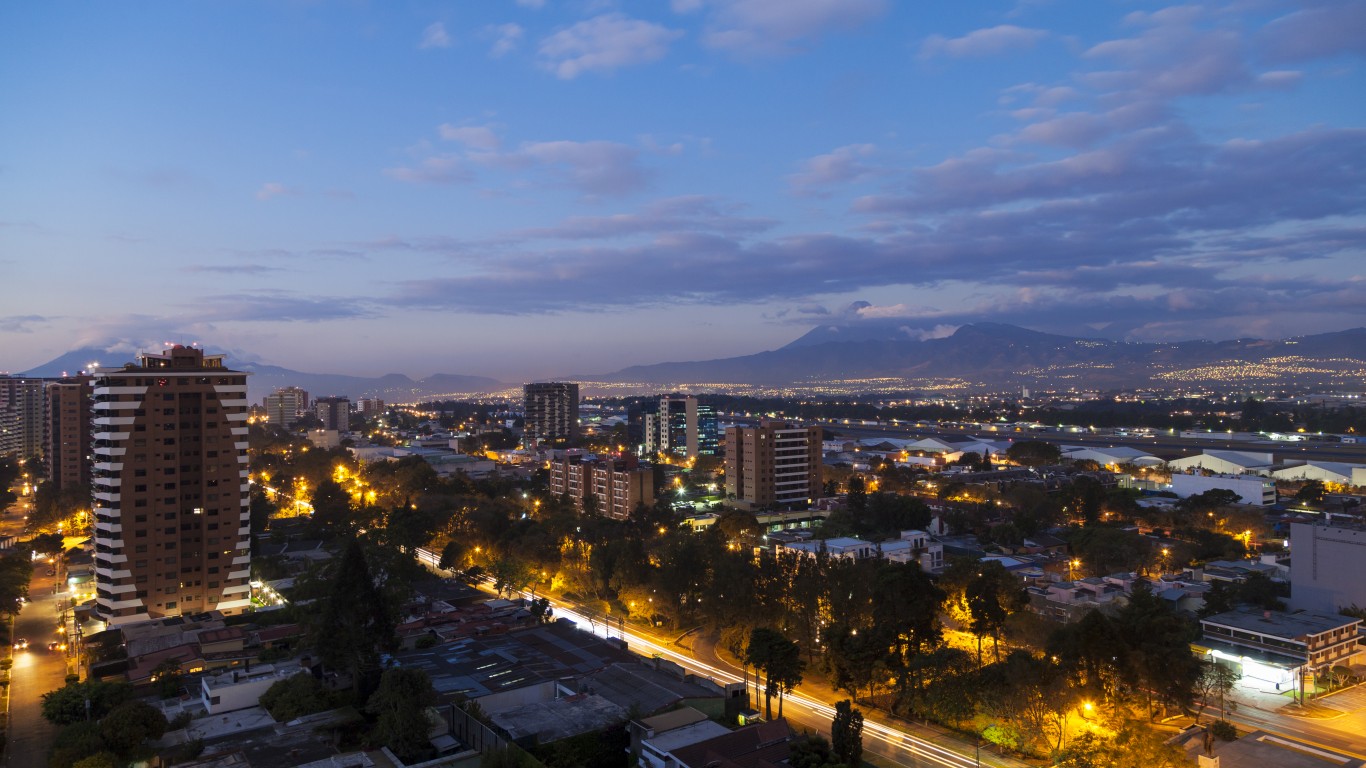
24. Guatemala, Guatemala
> Homicides per 100,000: 53.5
> 2017 homicides: 1,705
> Population: 3,187,293
The Northern Triangle, as U.S. intelligence officials call it, consists of Honduras, Guatemala and El Salvador. All three countries have been ravaged for years by gang activity and drug trafficking. Many in these countries come to the United States as undocumented immigrants or asylum seekers. The homicide rate in Guatemala City, one of the world’s most dangerous cities for years, has been hovering at about the same rate since 2014, after a bloody spike in murders pushed the city to No. 8 on the list in 2013.
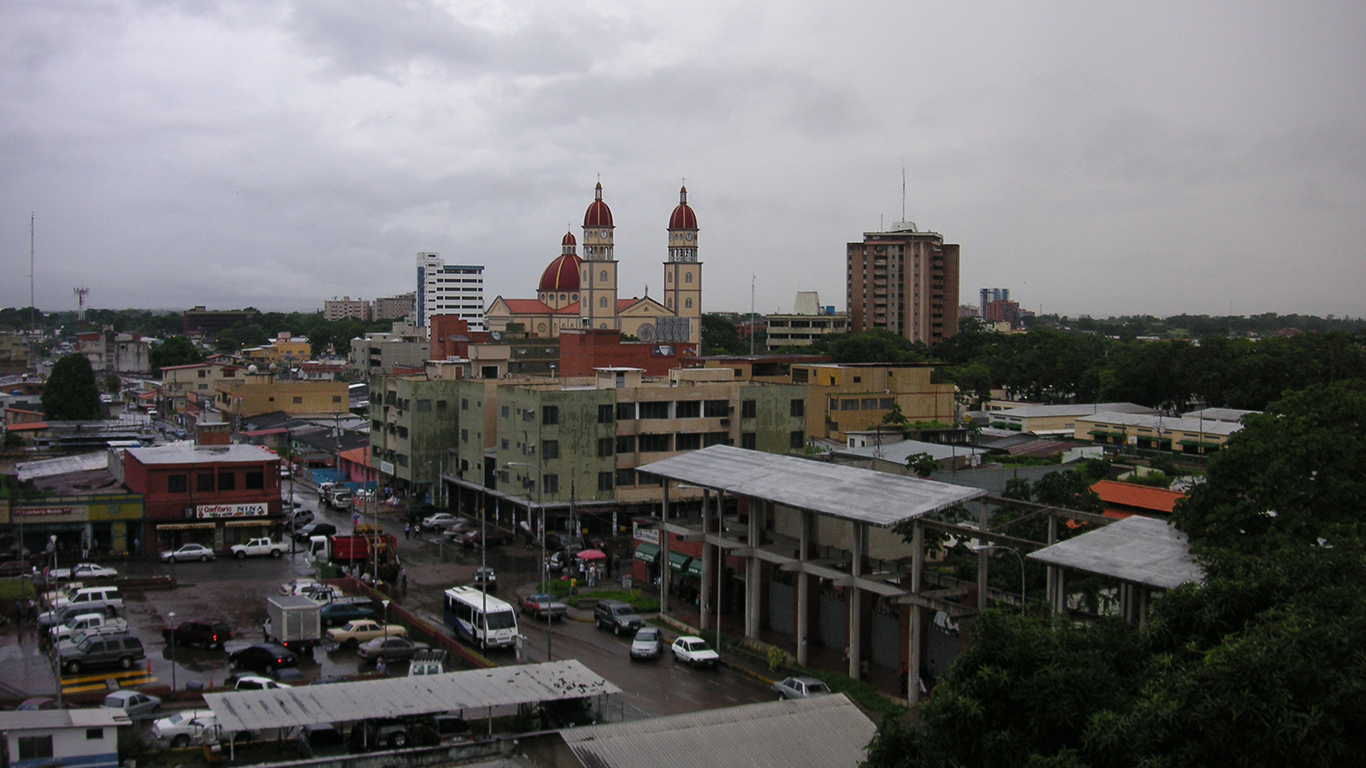
23. Maturín, Venezuela
> Homicides per 100,000: 54.4
> 2017 homicides: 327
> Population: 600,722
Maturín, situated in an oil-rich region in eastern Venezuela, has been hit hard by the country’s political and economic crises, including President Nicolás Maduro’s power grab and ensuing mass protests and counter-protests, hyperinflation, food shortages, crippling public debt, declining oil output and rampant crime. But like other major cities on this list, the homicide rate declined last year due a crackdown by state authorities on violent crime. Four out of five of the Venezuelan cities on this list have ranked in the top 10 most dangerous cities in the world at least once since 2013.
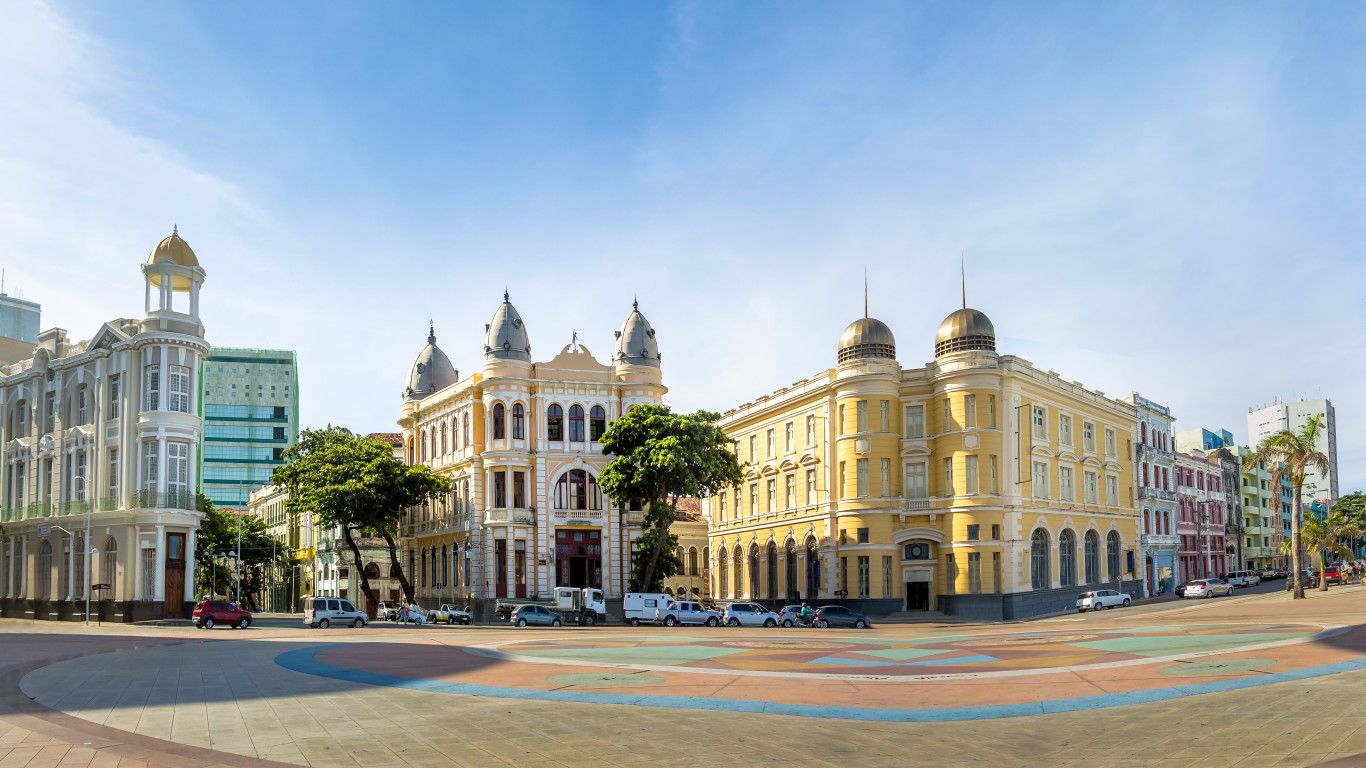
22. Recife, Brazil
> Homicides per 100,000: 55.0
> 2017 homicides: 2,180
> Population: 3,965,699
Having one of the highest per-capita GDPs in Brazil and a thriving technology hub has not done much to reduce this eastern Brazilian port city’s homicide rate. After a period of improvement from 2007 to 2014 under a state crime-fighting program, murders have gradually ticked upward since 2015, when the homicide rate was 38.1 out of 100,000 residents. Violent crime was likely exacerbated by the country’s crippling economic and political crises, pushing Recife’s rank further up the list.
[in-text-ad-2]
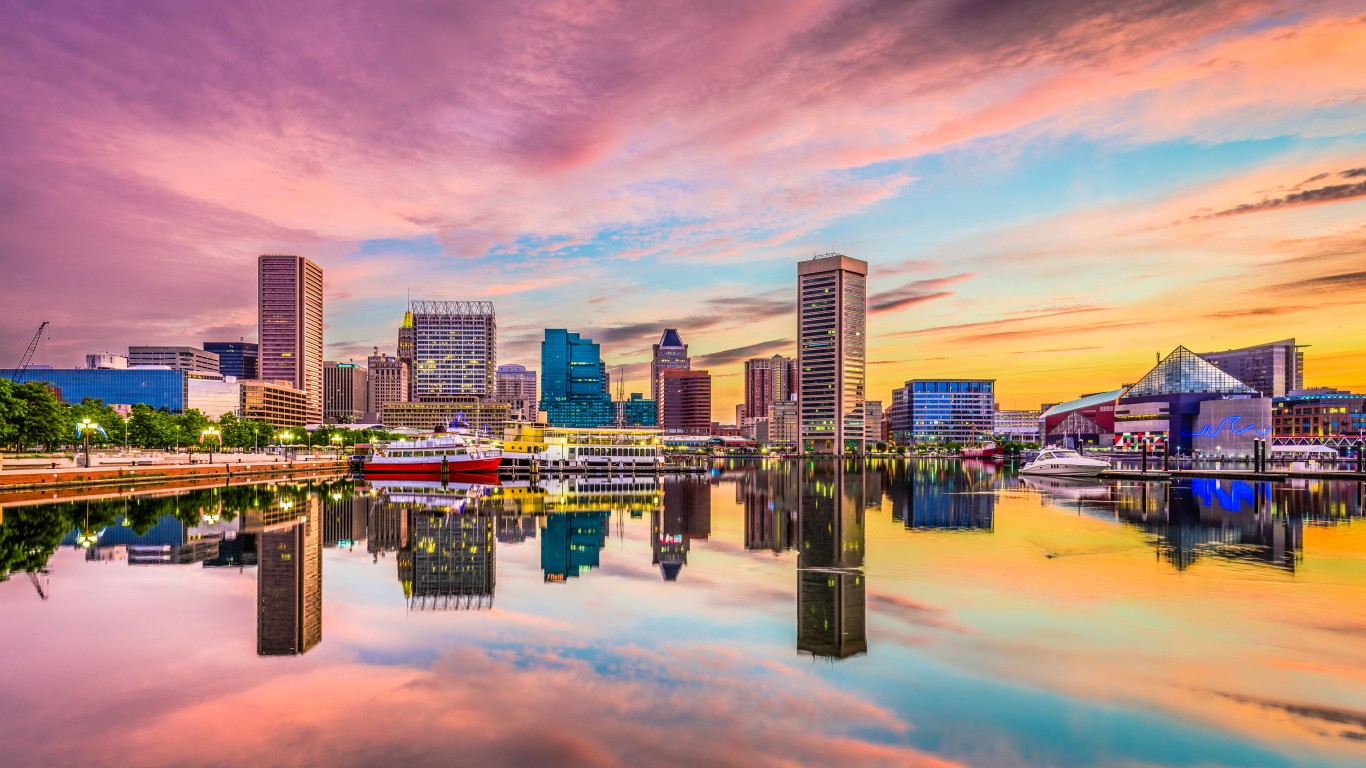
21. Baltimore, United States
> Homicides per 100,000: 55.5
> 2017 homicides: 341
> Population: 614,664
The number of murders in Baltimore increased to a record 343 in 2017 after a slight decline in 2016. But when adjusting for the city’s declining population, the murder rate hit a record high of 55.5 murders per 100,000 residents. Reasons and explanations for the city’s persistent murder problem include the rise in illegal guns, more street-level opioid dealing, and few job opportunities for the city’s sizeable low-income population. Some have accused local police of neglecting several high-crime areas.
The number of murders in Baltimore increased to a record 343 in 2017 after a slight decline in 2016. But when adjusting for the city’s declining population, the murder rate hit a record high of 55.5 murders per 100,000 residents.
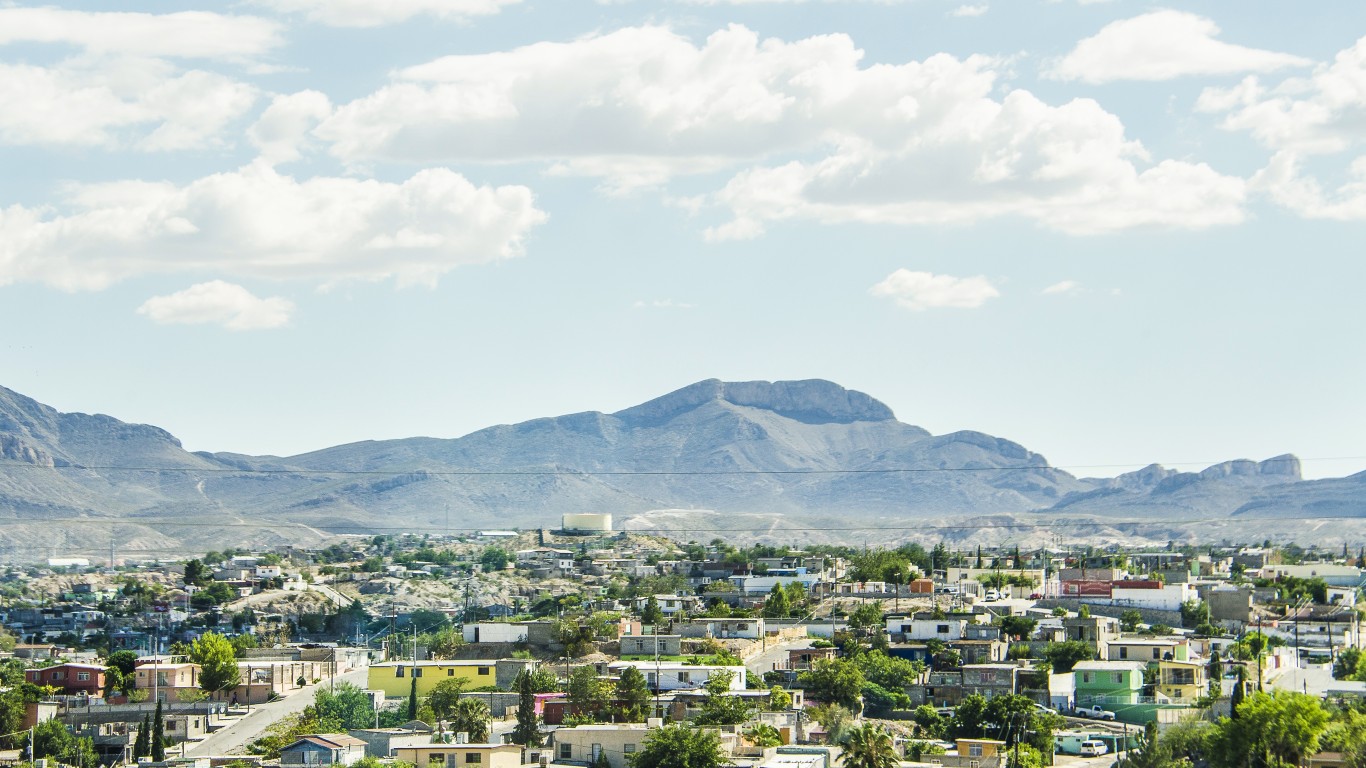
20. Juárez, Mexico
> Homicides per 100,000: 56.2
> 2017 homicides: 814
> Population: 1,448,859
Like in the city of Chihuahua, 225 miles to the south, there was an increase in the murder rate in the border city of Juárez in 2017 compared to 2016. And much like the eponymous state capital, the reasons seem to be linked to an increase in turf wars among street-level meth dealers with connections to larger criminal organizations. The city reported more than 700 murders last year, including 87 in December alone, as rival drug gangs escalated their activities.
[in-text-ad]
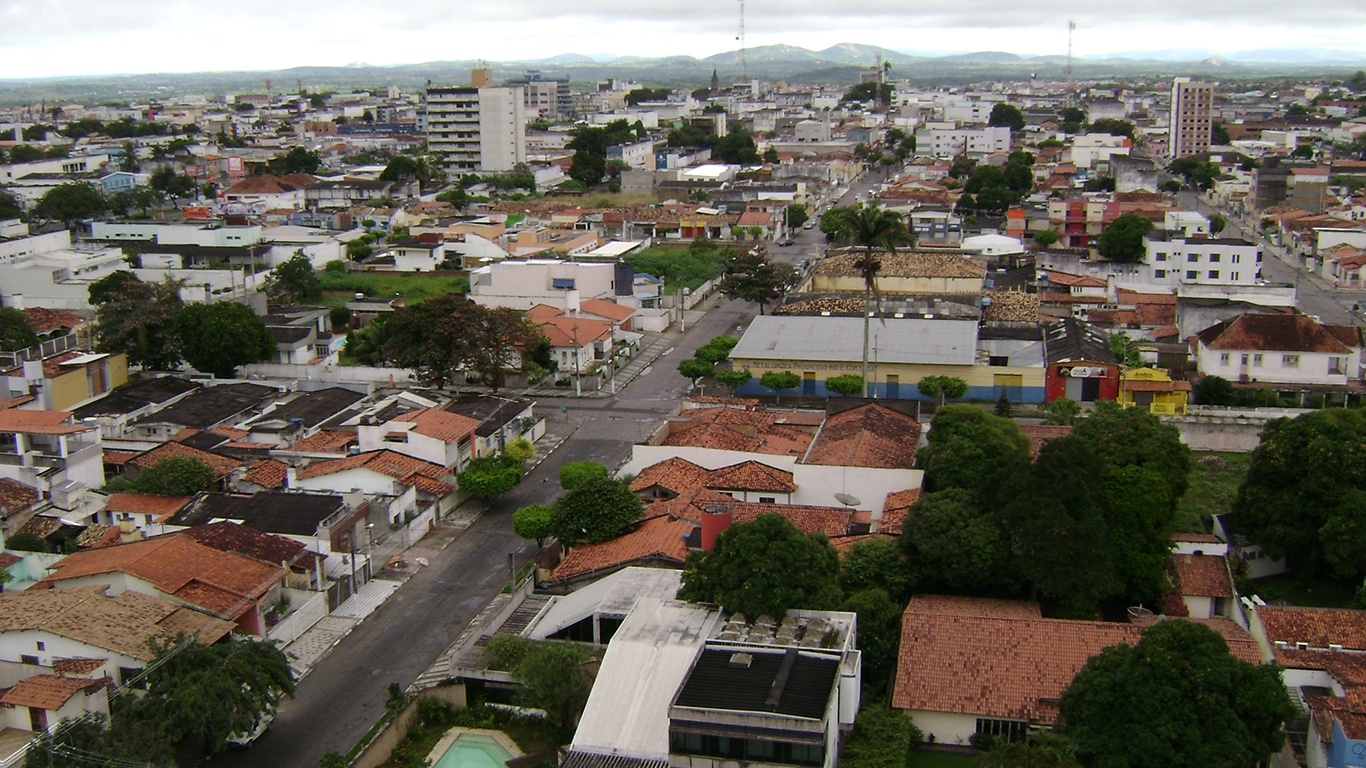
19. Feira de Santana, Brazil
> Homicides per 100,000: 58.8
> 2017 homicides: 369
> Population: 627,477
Unlike the nearby port city of Salvador, Feira de Santana’s homicide rate has been in the top 20 since 2016. The city is a crossroads for goods coming from the south and central parts of the country into Salvador, 60 miles to the southeast. This conduit enables drug trafficking that feeds gang-related activity. As the homicide rate dropped in Salvador, it has increased in nearby Feira de Santana.
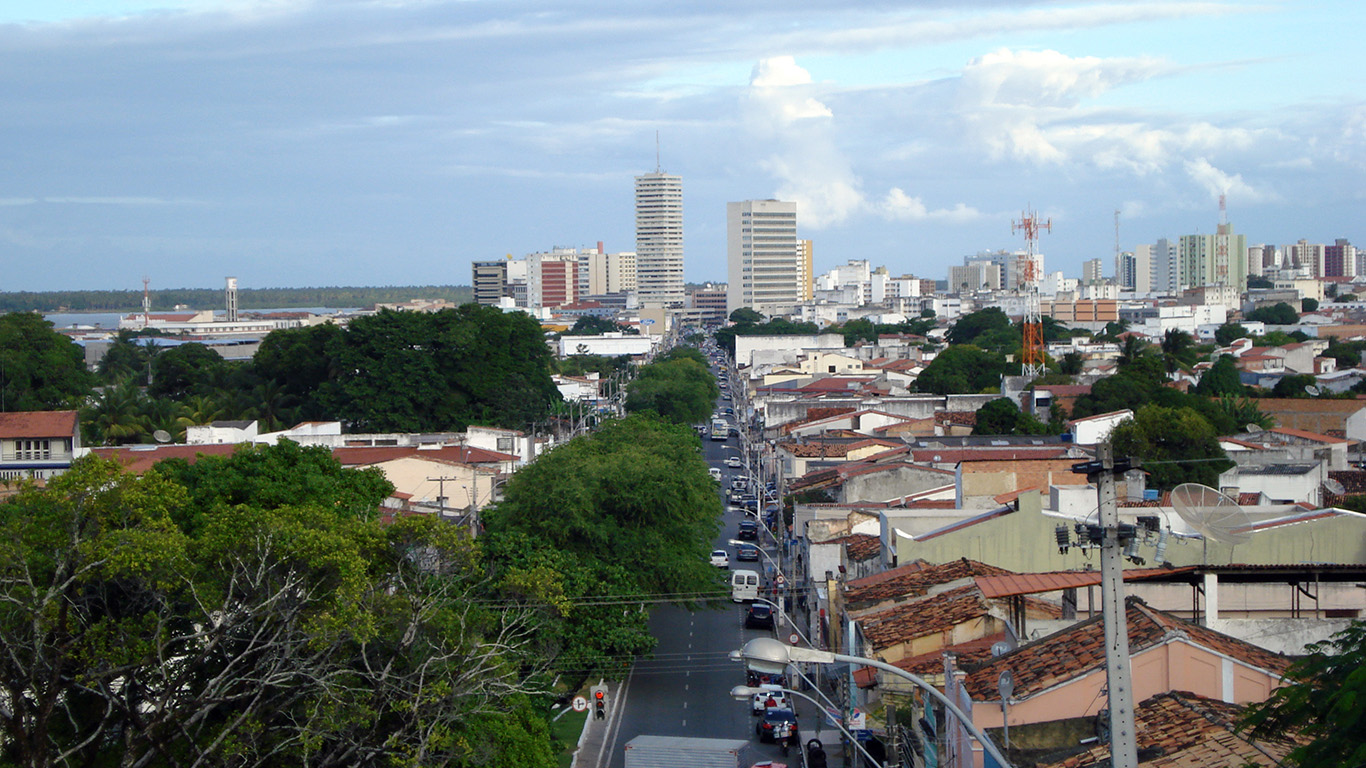
18. Aracaju, Brazil
> Homicides per 100,000: 58.9
> 2017 homicides: 560
> Population: 951,073
With heavy government investment in infrastructure and promotion and pleasant weather year-round, Aracaju has emerged as a tourism center for eastern Brazil. But its homicide rate makes it Brazil’s sixth most dangerous city, and the trend in recent years is worrying. Tourism can attract the drug trade, which can attract rival gang activity that requires heavy police enforcement to combat, as it does in Rio de Janeiro. In 2014, Aracaju ranked 39th on the list with 34.2 homicides per 100,000 residents; since then the murder rate has increased 72%.

17. San Salvador, El Salvador
> Homicides per 100,000: 59.1
> 2017 homicides: 1,057
> Population: 1,789,588
Like the other two countries of the Northern Triangle, El Salvador has been facing violent street gangs and drug traffickers that have turned many of its streets into war zones. As a result, thousands have fled the area’s economic hardships and danger, attempting to enter the United States. In 2017, the homicide rate dropped in the capital city of San Salvador as police and military stepped up enforcement action, but the city has been in the top 20 most dangerous cities since 2014, hitting No. 3 two years ago.
[in-text-ad-2]
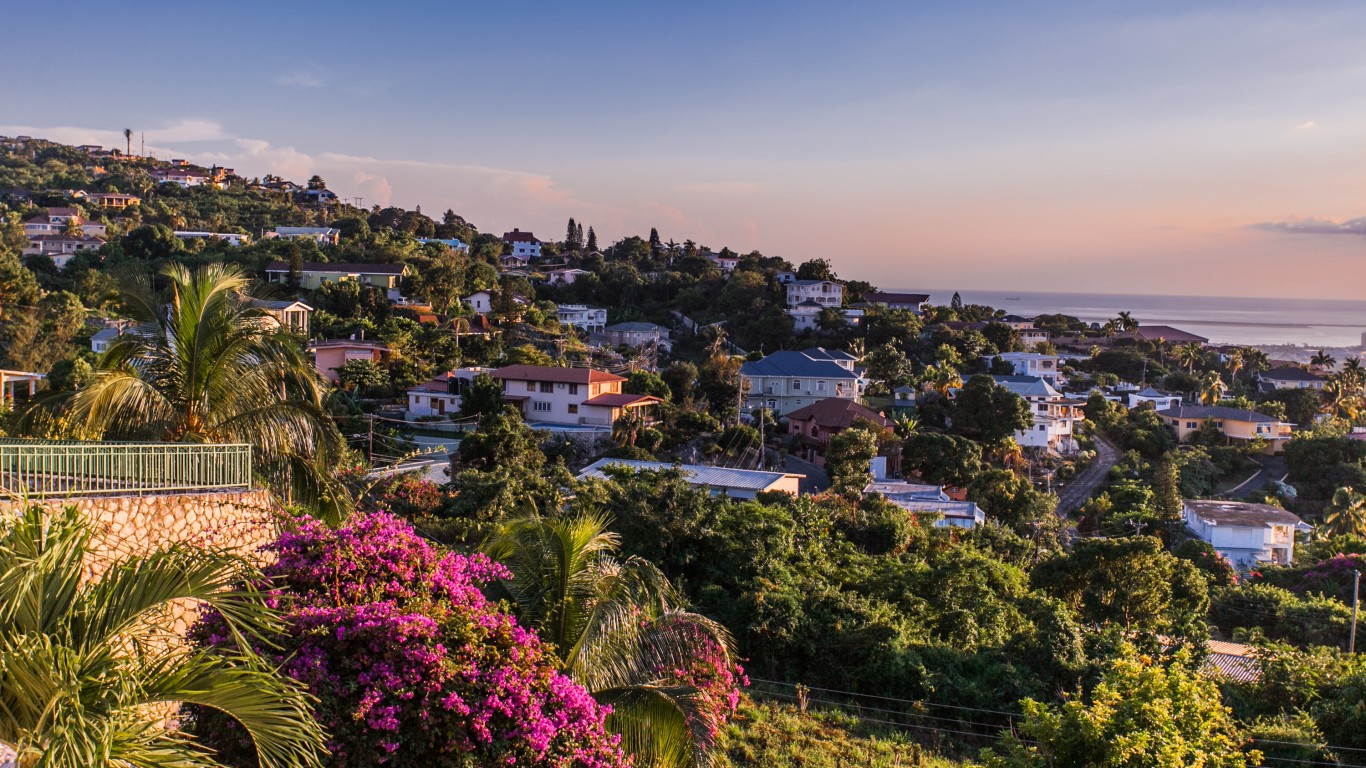
16. Kingston, Jamaica
> Homicides per 100,000: 59.7
> 2017 homicides: 705
> Population: 1,180,771
The homicide rate in Jamaica’s capital jumped last year after several years of improvement. The increase comes as local authorities stepped up enforcement actions against Jamaican “posses,” a local term for criminal gangs, that fight over turf in Jamaica and its surrounding parishes. Like elsewhere, killing can spike after gang leaders are killed or arrested by police, as gang members seek retribution against police or snitches, or fight to replace the ousted leaders. Last year, Kingston fell back into the list of the top 20 most dangerous cities for the first time since 2013.
The homicide rate in Jamaica’s capital jumped last year after several years of improvement. The increase comes as local authorities stepped up enforcement actions against Jamaican “posses,” a local term for criminal gangs, that fight over turf in Jamaica and its surrounding parishes.
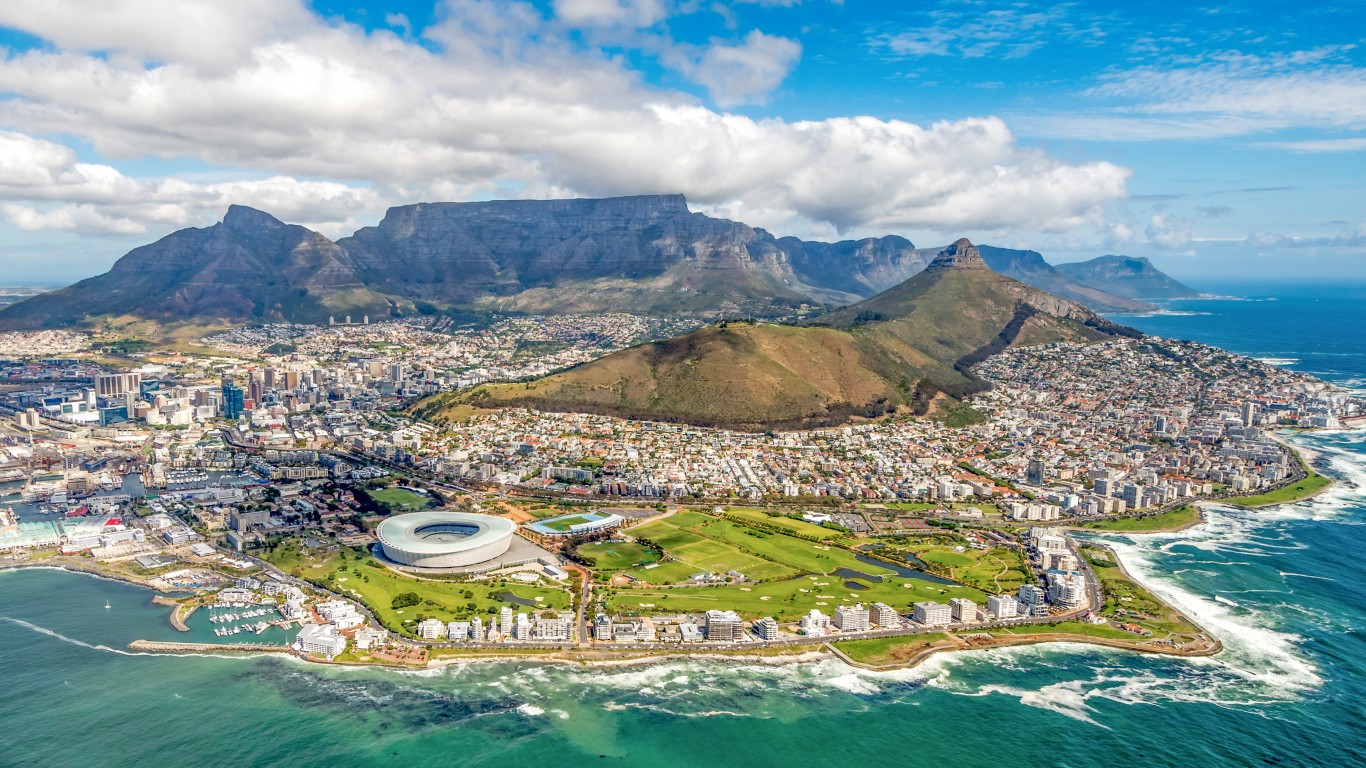
15. Cape Town, South Africa
> Homicides per 100,000: 62.3
> 2017 homicides: 2,493
> Population: 4,004,793
Cape Town is by far the murder capital of a country plagued with violence. Last year, overall reported crime in South Africa’s capital and largest city increased by 8%, but its homicide rate barely changed. Cape Town has been in the top 20 most dangerous cities since Seguridad, Justicia y Paz began tracking homicide rates in 2013, peaking at No. 9 in 2015.
[in-text-ad]
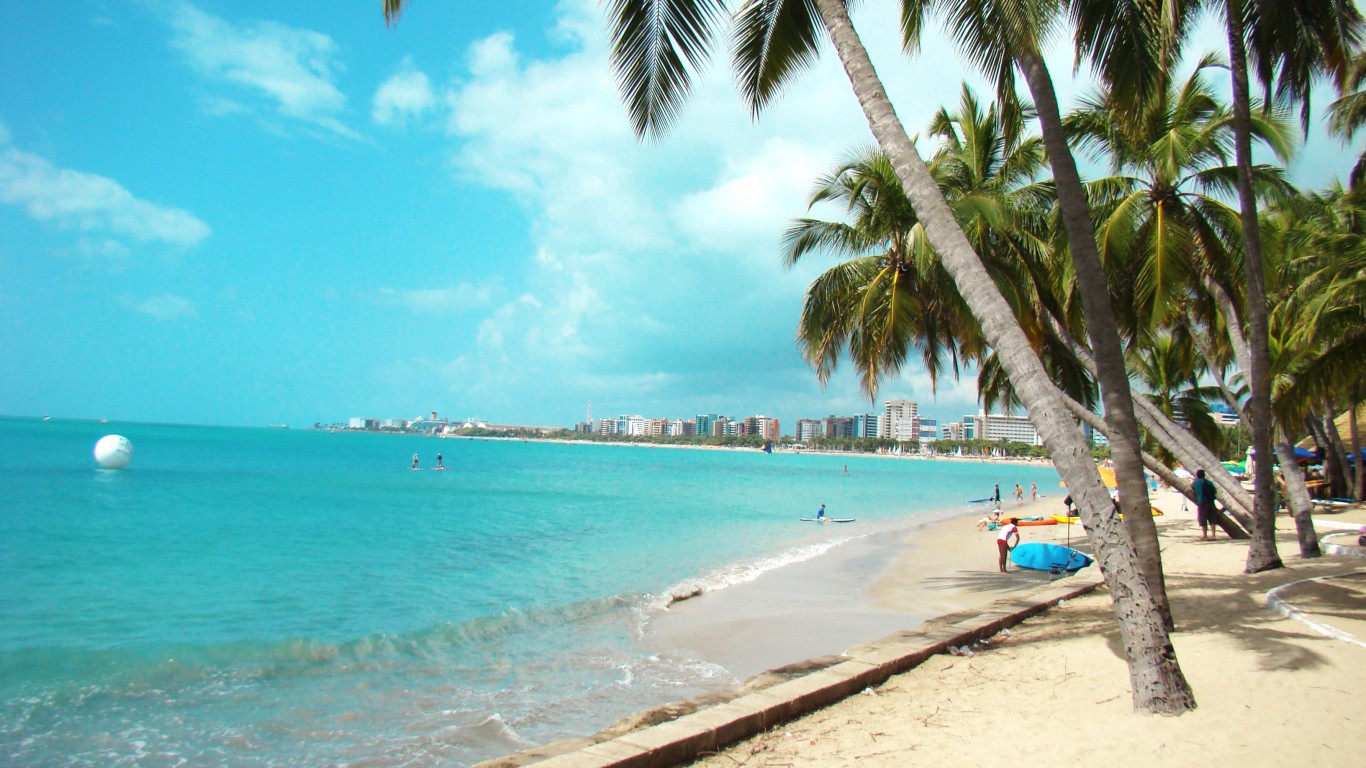
14. Maceió, Brazil
> Homicides per 100,000: 63.9
> 2017 homicides: 658
> Population: 1,029,129
Unlike in Aracaju, 170 miles to the south, the homicide rate in the coastal city of Maceió increased last year from 51.8 homicides for every 100,000 residents in 2016 to 63.9 per 100,000, pushing its ranking from the 25th spot to 14th. It is an improvement from 2014, however, when this touristic city was the country’s second most dangerous with 72.9 homicides per 100,000 residents. The trend shows that despite improved economic conditions in Brazil — the country’s crippling recession that began in 2014 ended last year — many cities struggle with gang-related violent criminal activity, and police enforcement varies from brutal to non-existent depending on how crime is tackled.
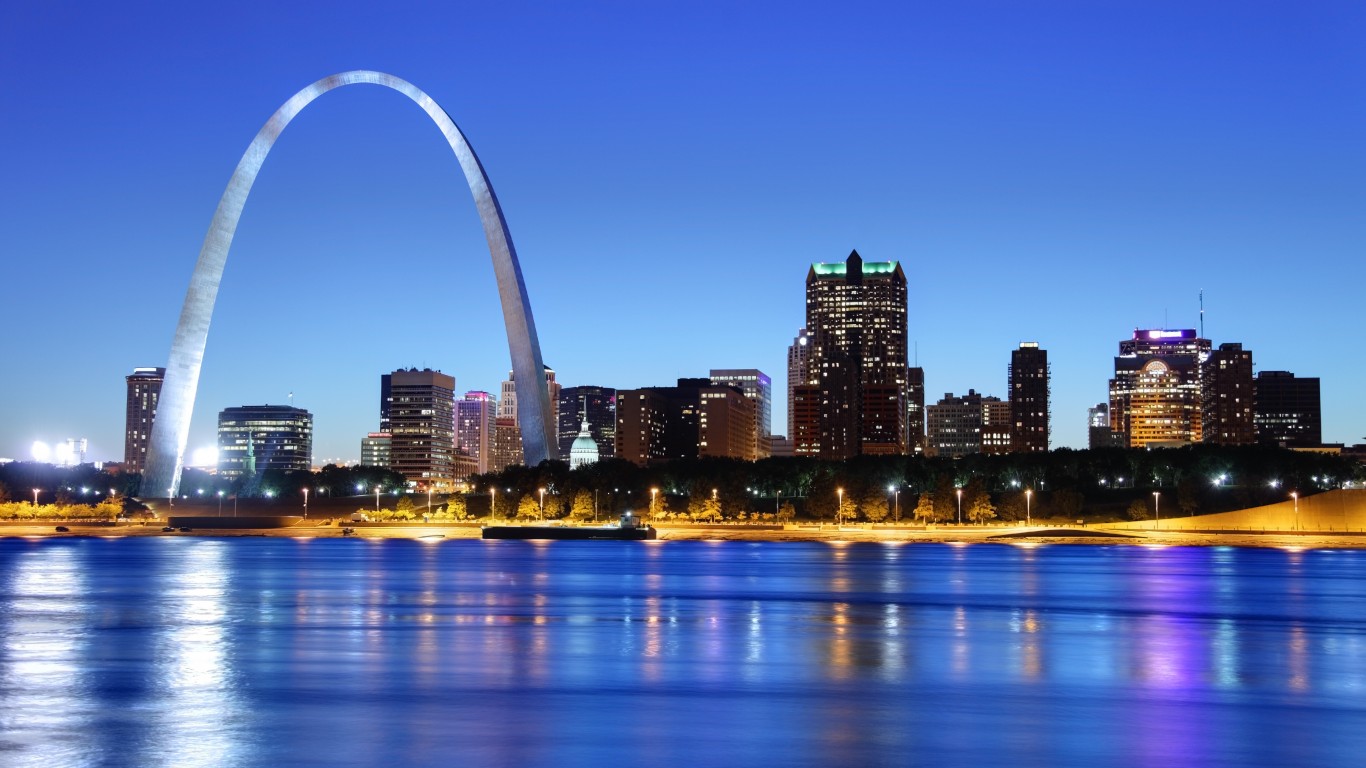
13. St. Louis, United States
> Homicides per 100,000: 65.8
> 2017 homicides: 205
> Population: 311,404
Since 2014, this Mississippi port city has been among the world’s 20 most dangerous cities on the annual list, and its homicide rate has gradually increased. The city’s homicide rate is the same as some of the most murderous cities in Mexico and Brazil. Like other U.S. cities on this list, St. Louis authorities are struggling to bring killers to justice in the most marginalized neighborhoods in the city. In some areas, only one in three homicides result in an arrest of suspects. Like in other homicide-heavy U.S. cities, police are trying to build trust in communities to encourage people to report crime and to reach out to troubled youths.
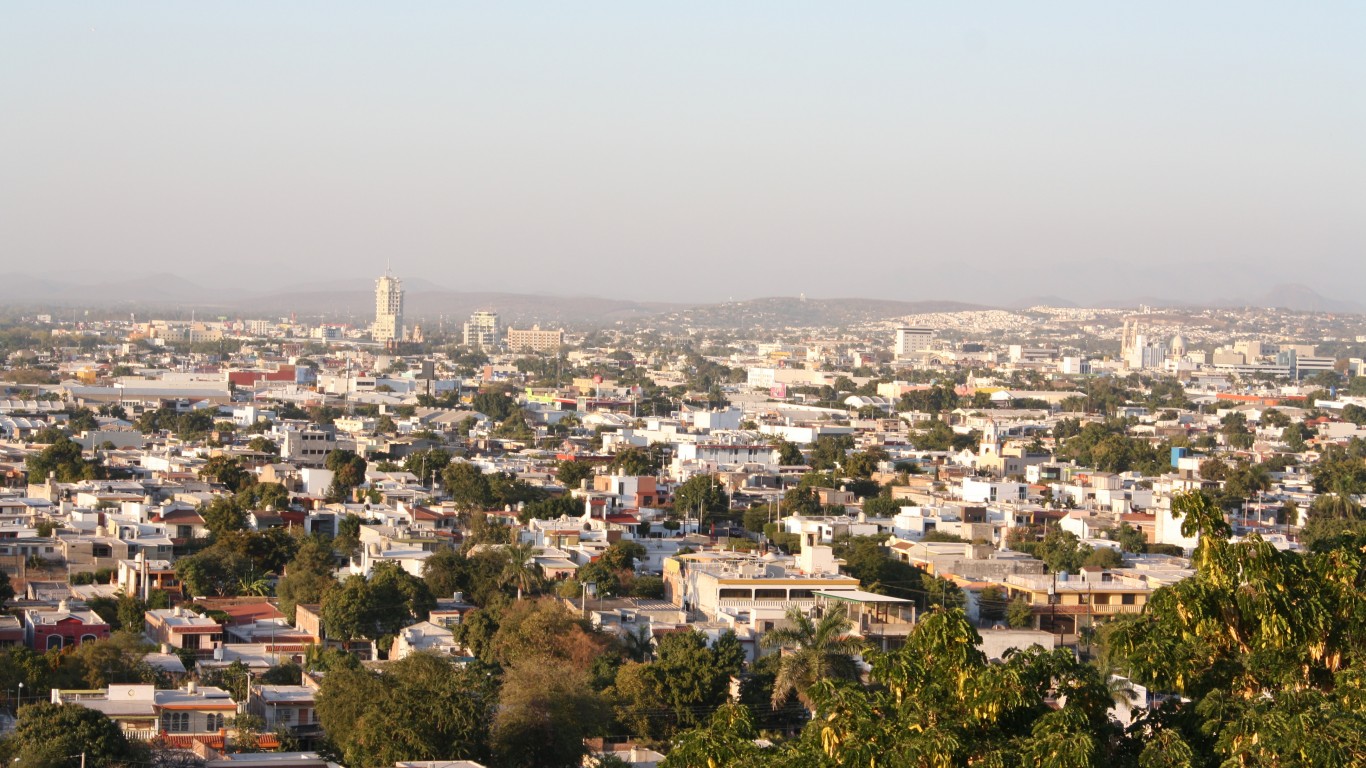
12. Culiacán, Mexico
> Homicides per 100,000: 70.1
> 2017 homicides: 671
> Population: 957,613
Culiacán, in the northwestern state of Sinaloa, has long been a center of drug cartel activity. Last year, the city’s consistently high murder rate jumped from 51.8 homicides per 100,000 residents to 70.1 per 100,000, owing largely to the street-level fallout following the extradition of Joaquin “El Chapo” Guzman Loera, the head of the Sinaloa Cartel, to the United States. Although he is in custody in Brooklyn, a cartel war broke out after Guzman’s former political operator reportedly attempted to kill Guzman’s sons. Confirming the links between cartel inner-struggles and the rise in murders is difficult, but one thing is certain: Guzman’s removal has stemmed neither the local narcotics trade nor the blood it spills.
[in-text-ad-2]
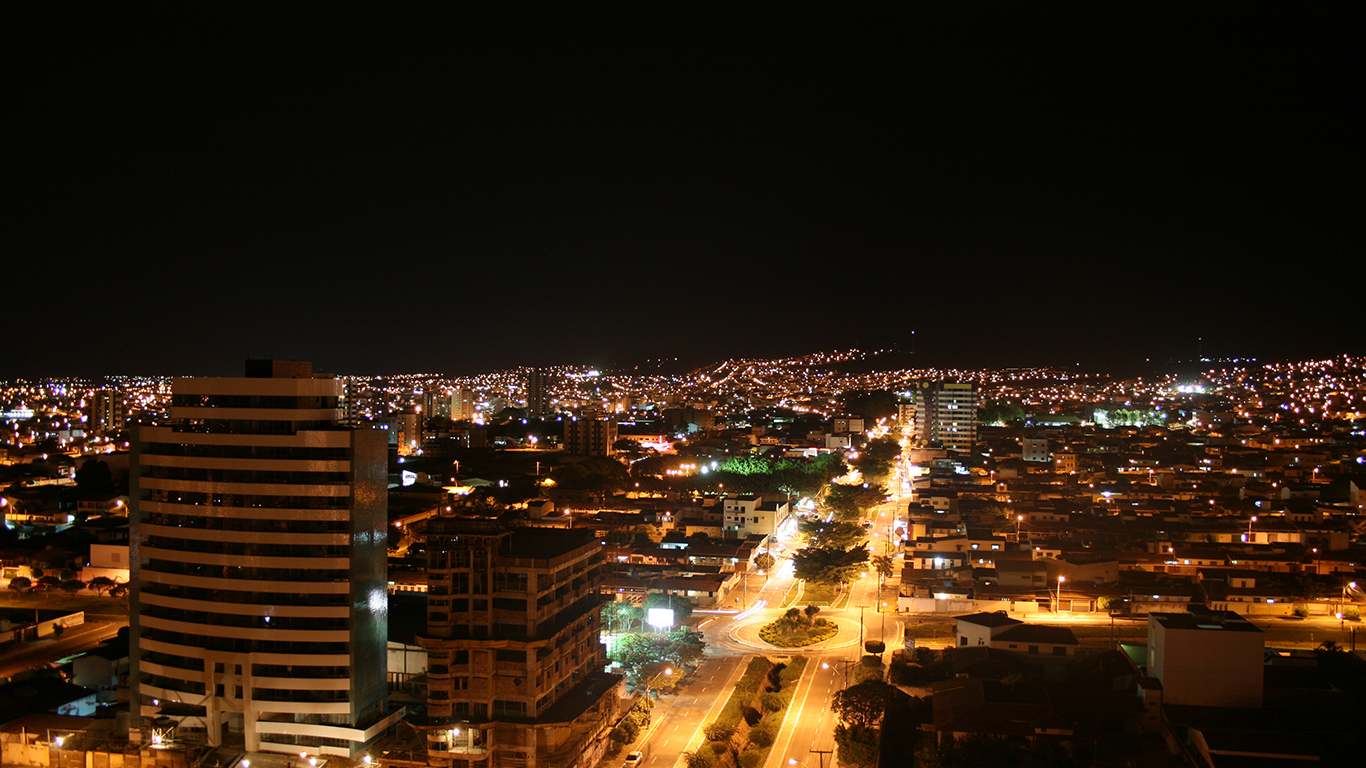
11. Vitória da Conquista, Brazil
> Homicides per 100,000: 70.3
> 2017 homicides: 245
> Population: 348,718
Brazil’s eastern Bahia state business center reported a jump in the number of homicides in the past couple of years, making it the country’s fourth bloodiest city. Cities in country’s northeast, which includes Bahia, have reported an alarming increase in murders. The World Bank estimated that murders in Bahia more than tripled between 2000 and 2010. After a notable drop in the murder rate in 2015 to 38.5 homicides per 100,000 residents, the rate has nearly doubled in the past couple of years.
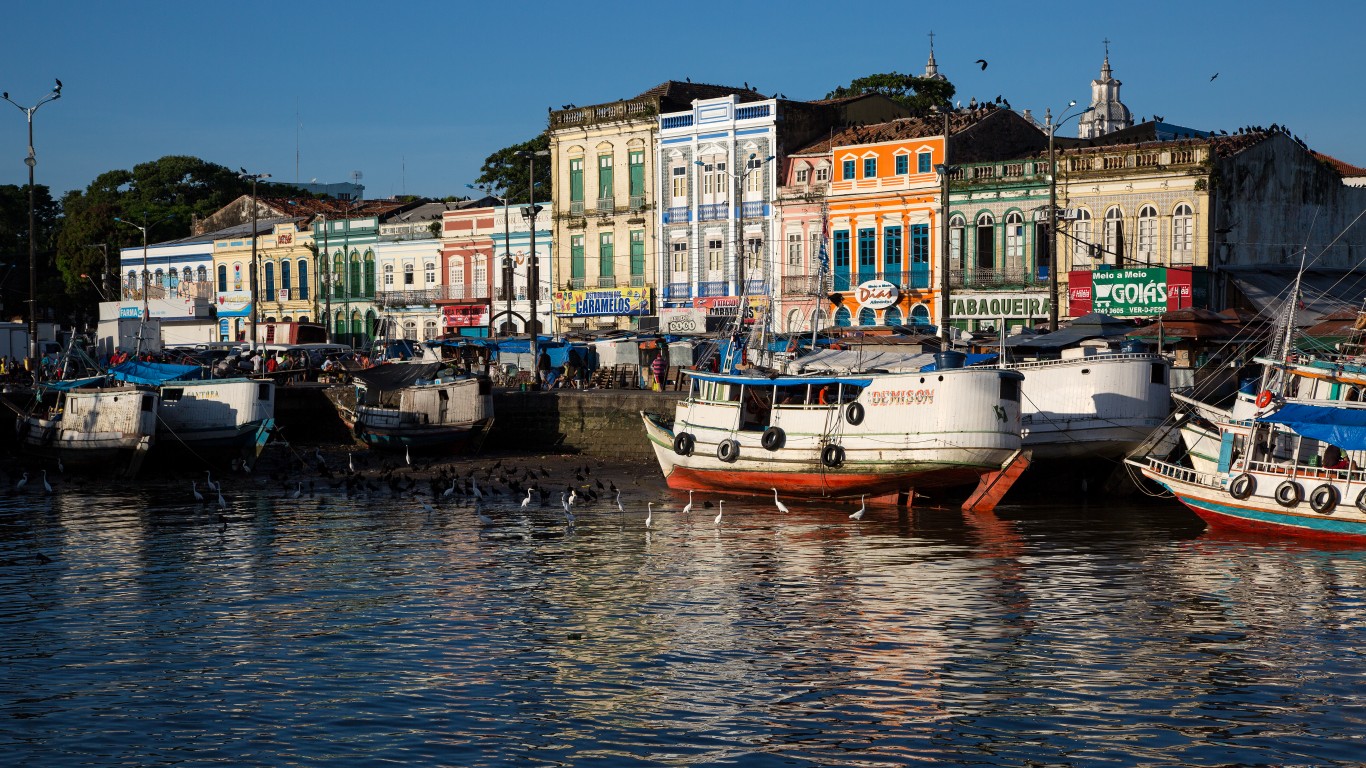
10. Belém, Brazil
> Homicides per 100,000: 71.4
> 2017 homicides: 1,743
> Population: 2,441,761
In 2014, 10 people were gunned down in Belém in what Amnesty International called an act of revenge for the murder of a military police force officer. The killings, which received global public attention at the time, underscored the tensions between criminal gangs and street-level officers in this Amazon River port city, a conduit of agricultural goods and mining commodities extracted from the Amazon rainforest. Belém made it into the top 10 most dangerous cities list in 2017 after ranking 26th, with 45.8 homicides per 100,000 residents, two years earlier. It is now Brazil’s third most dangerous city.
[in-text-ad]
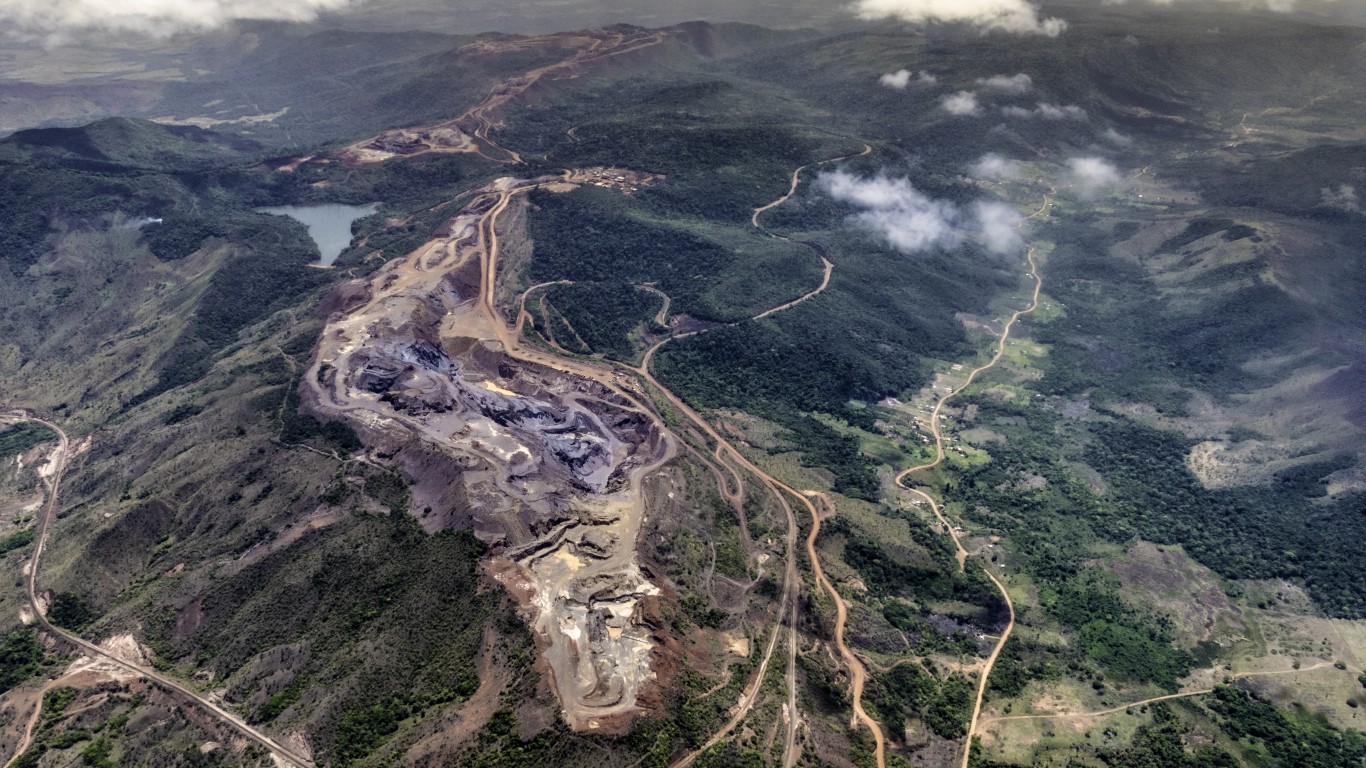
9. Guayana, Venezuela
> Homicides per 100,000: 80.3
> 2017 homicides: 728
> Population: 906,879
Ciudad Guayana, a Venezuelan ports city on the banks of the Orinoco River has been on the list of the top 10 most dangerous cities in the world in the past two years, climbing from 17th in 2013. Like elsewhere in the country, the city is struggling with food scarcities and high crime amid Venezuela’s years-long and worsening economic conditions. The country’s spiraling crime rate has made it the top source of asylum seekers to the United States.
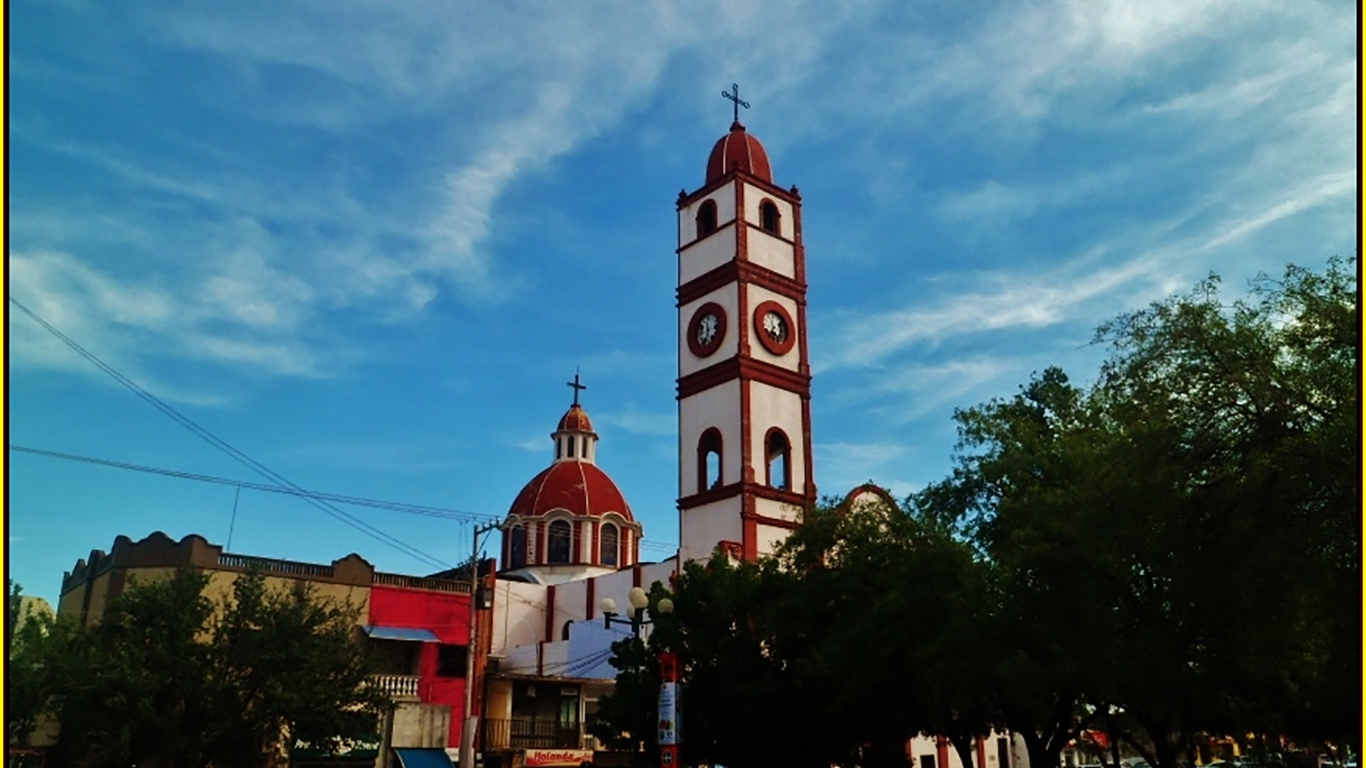
8. Victoria, Mexico
> Homicides per 100,000: 83.3
> 2017 homicides: 301
> Population: 361,078
Like Reynosa, 200 miles to the north, Ciudad Victoria has reported a sharp increase in murders since 2015 as simmering disputes between rival drug trafficking gangs have boiled over in the past couple of years. The murder rate in the capital of Tamaulipas state, one of the most lawless in the country, has nearly tripled in two years with little respite in sight; there were more murders in the first four months of this year than in the same period of 2017.
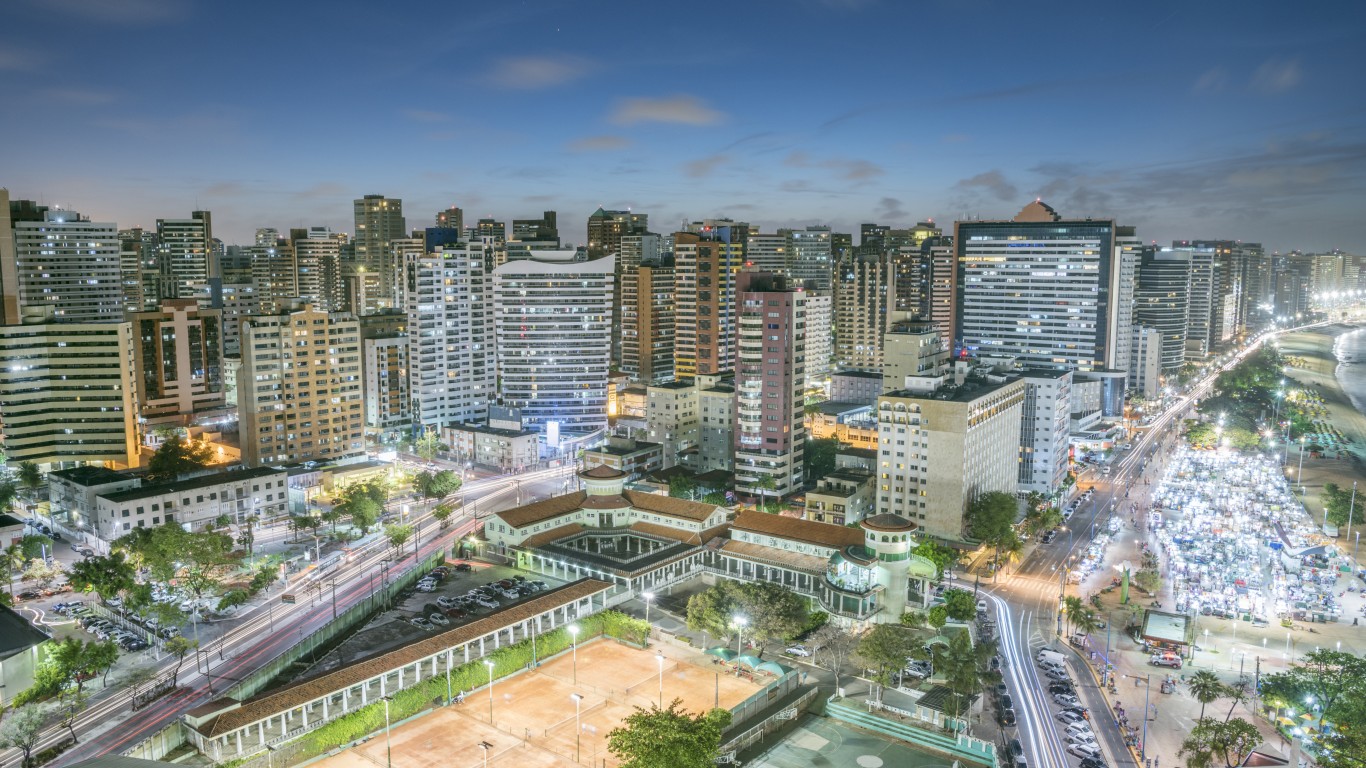
7. Fortaleza, Brazil
> Homicides per 100,000: 83.5
> 2017 homicides: 3,270
> Population: 3,917,279
As one of Brazil’s wealthiest cities, this eastern port city holds a significant cultural and business cache. But unlike Rio de Janeiro and São Paulo, also cultural and economic centers, gang-related killings in Fortaleza make it the country’s second most dangerous city. In 2016, the city ranked 35th with 45.0 homicides per 100,000 people. And the city got off to a bad start in 2018 when 14 people were massacred in a nightclub in February. As with elsewhere in Brazil, effective police strategies to deal with criminal gangs have been elusive, partly because Brazil’s crime problem is linked to racism, deep economic inequalities, and inadequate municipal services in the poorest neighborhoods.
[in-text-ad-2]
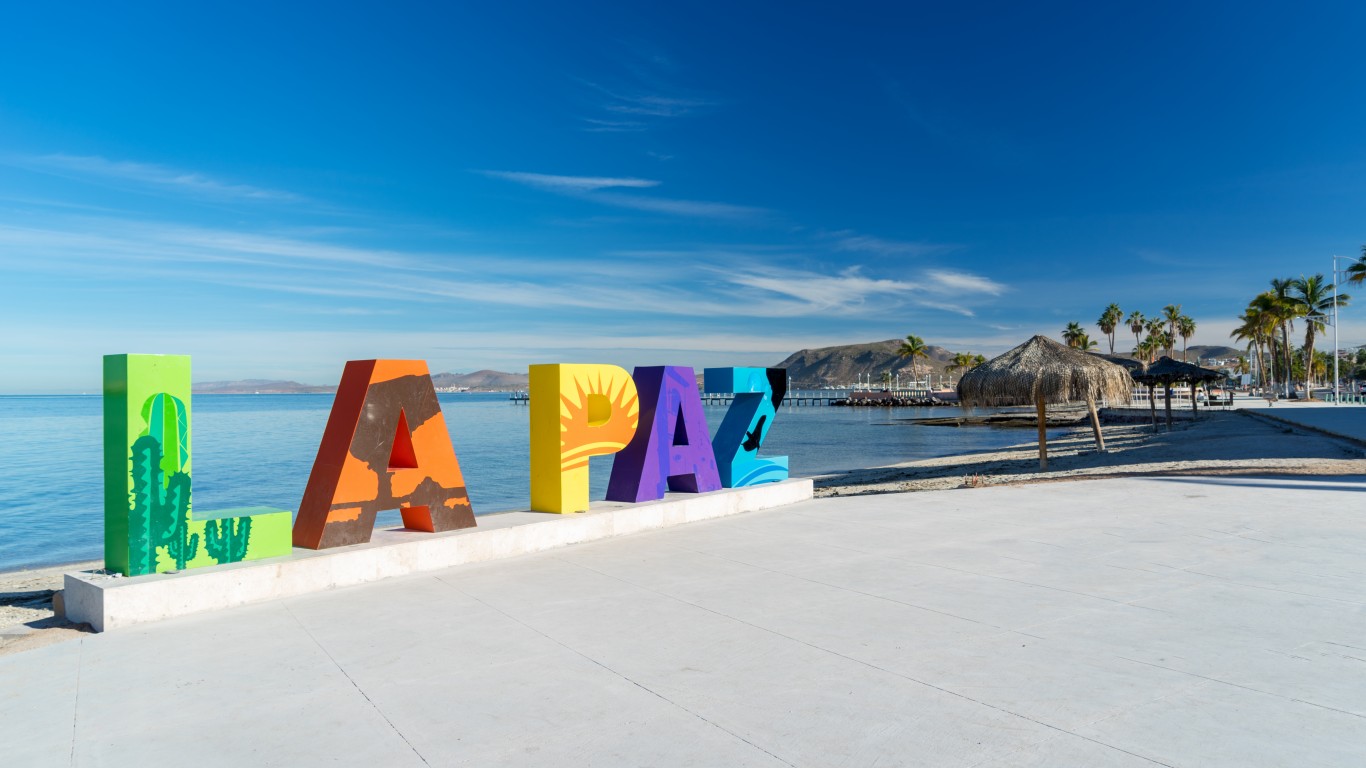
6. La Paz, Mexico
> Homicides per 100,000: 84.8
> 2017 homicides: 259
> Population: 305,455
La Paz means “peace” in English, but the situation in this southern Baja California city on the coast of the Gulf of California has been anything but peaceful. This is the first time La Paz has appeared on the world’s top 50 most dangerous cities list since Seguridad, Justicia y Paz began tracking homicide rates in 2013. This sharp increase in killings is perhaps one of the most troubling developments in Mexico’s crime problems because the southern half of the Baja California state has been spared much of the violence taking place nearby. The area’s low population has insulated the southern part of the peninsula from the centers of cartel power. But now it appears that Baja California is no longer insulated from the criminal enterprises taking place across the narrow gulf.

5. Tijuana, Mexico
> Homicides per 100,000: 100.8
> 2017 homicides: 1,897
> Population: 1,882,492
Tijuana, the gritty border city just south of San Diego, has always had a seedy reputation even if its residents blanch at the stereotypes perpetuated by Americans north of the border. But Tijuana’s homicide rate has steadily increased over the past five years. Last year, the city reported a precipitous jump in the murder rate, topping 100 homicides per 100,000 residents, up from 32.5 per 100,000 in 2013. In just 12 months, Tijuana’s ranking climbed to become the fifth most dangerous city. Like La Paz and Los Cabos — two other cities on this list situated on the Baja Peninsula — Tijuana appears to be in the midst of a wave of murders as street-level drug dealers fight over turf.
[in-text-ad]
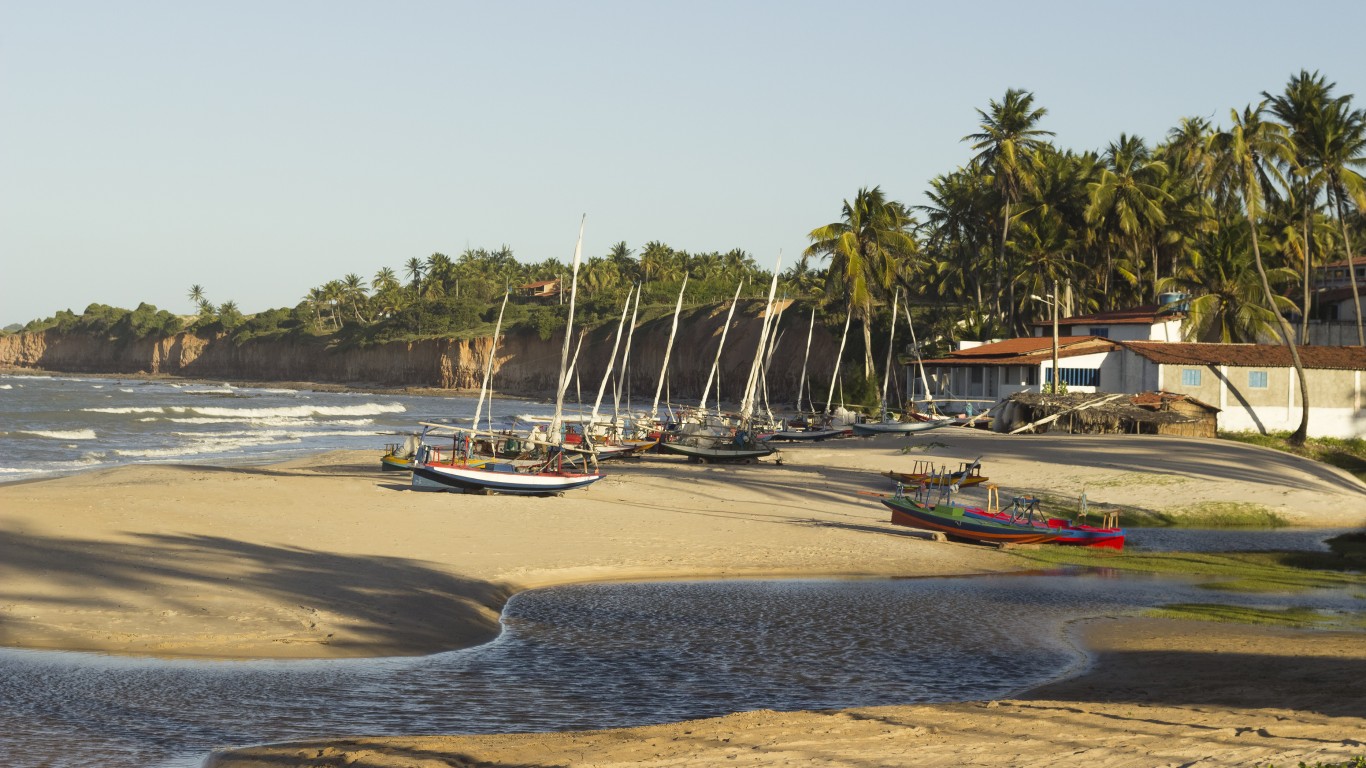
4. Natal, Brazil
> Homicides per 100,000: 102.6
> 2017 homicides: 1,378
> Population: 1,343,573
Natal is the capital and largest city in Rio Grande do Norte, the second largest oil-producing state in Brazil. Foreign travellers are lured to the city’s stretches of white sandy beaches, and it is a major exporter of tropical fruits and seafood. But it also has been Brazil’s bloodiest city over the past two years, with the murder rate rising from 63.7 homicides per 100,000 residents in 2014 to 102.6 per 100,000 in 2017. Interestingly, because crime rates have generally increased in other cities, Natal remained ranked as the world’s fourth most dangerous city.
It has been a rough decade for the residents of Natal, where two major criminal factions – the Primeiro Comando da Capital (or PCC) and Sindicato do Crime – fight turf wars as law enforcement forces struggle to quell the violence.
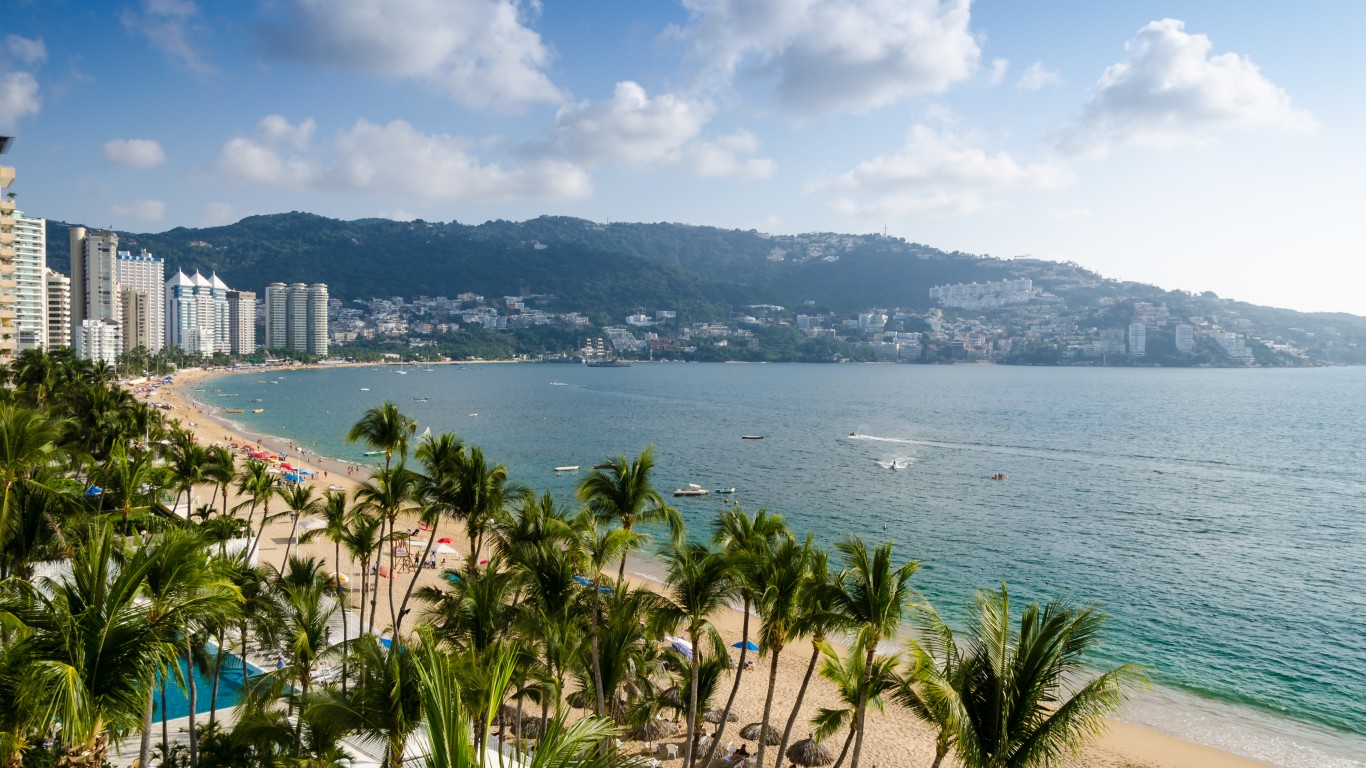
3. Acapulco, Mexico
> Homicides per 100,000: 106.6
> 2017 homicides: 910
> Population: 853,646
Acapulco, once the city that welcomed vacationing members of the Kennedy family and Hollywood stars, has become one of the hotspots for rival drug gang fighting. It has remained within the top five most dangerous cities in the world since Seguridad, Justicia y Paz began tracking homicides in 2013. Situated on the west coast of Guerrero, one of Mexico’s most violent and impoverished states, Acapulco remains one of the most popular tourist destinations in the country despite the high homicide rate.
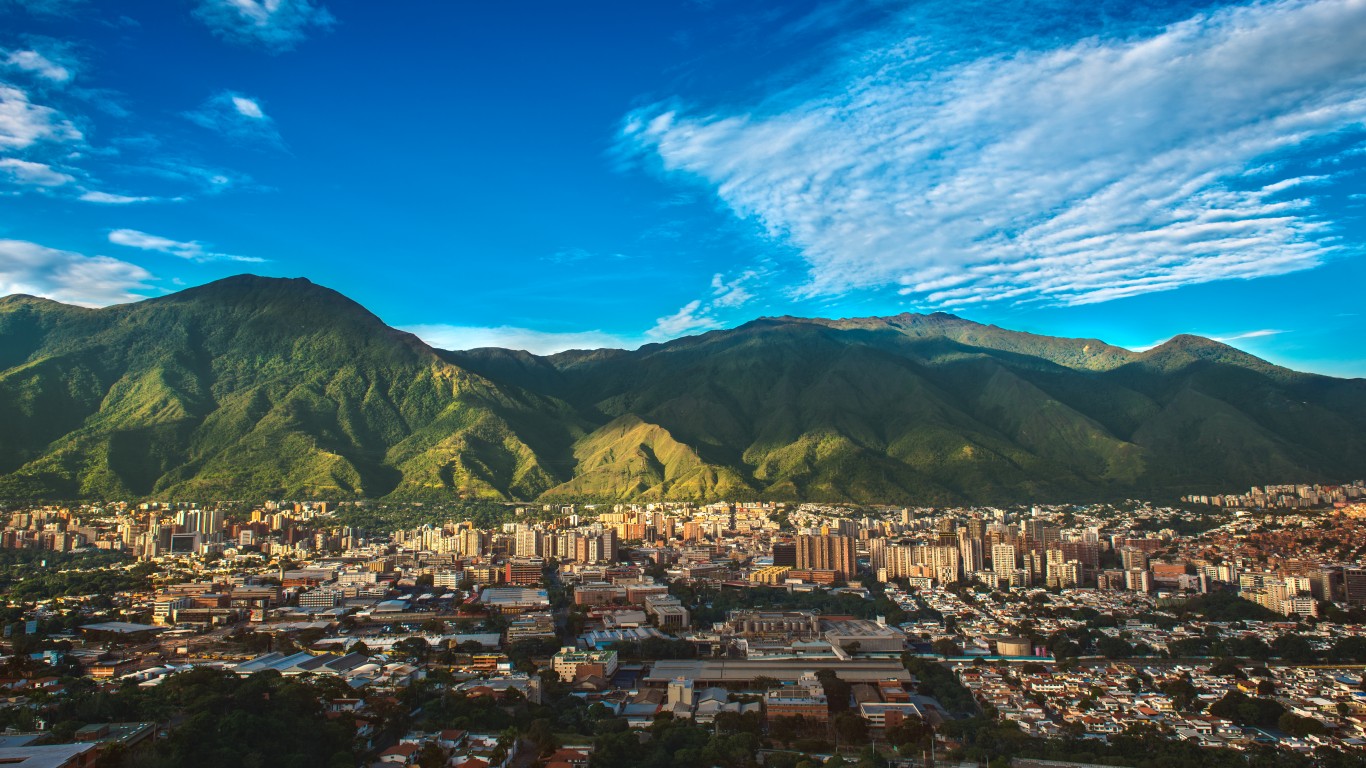
2. Caracas, Venezuela
> Homicides per 100,000: 111.2
> 2017 homicides: 3,387
> Population: 3,046,104
Venezuela’s capital has been ranked the most dangerous or second most dangerous city in the world since this annual list has been published in 2013. Caracas could therefore very well hold the rank as the world’s most dangerous place to live outside of a war zone. Venezuela’s ongoing political and economic crises have likely contributed significantly to the skyrocketing crime rates in the country. Caracas was knocked off the No. 1 position only after an unusual spike in homicides put Los Cabos, Mexico — on the list for the first time.
[in-text-ad-2]
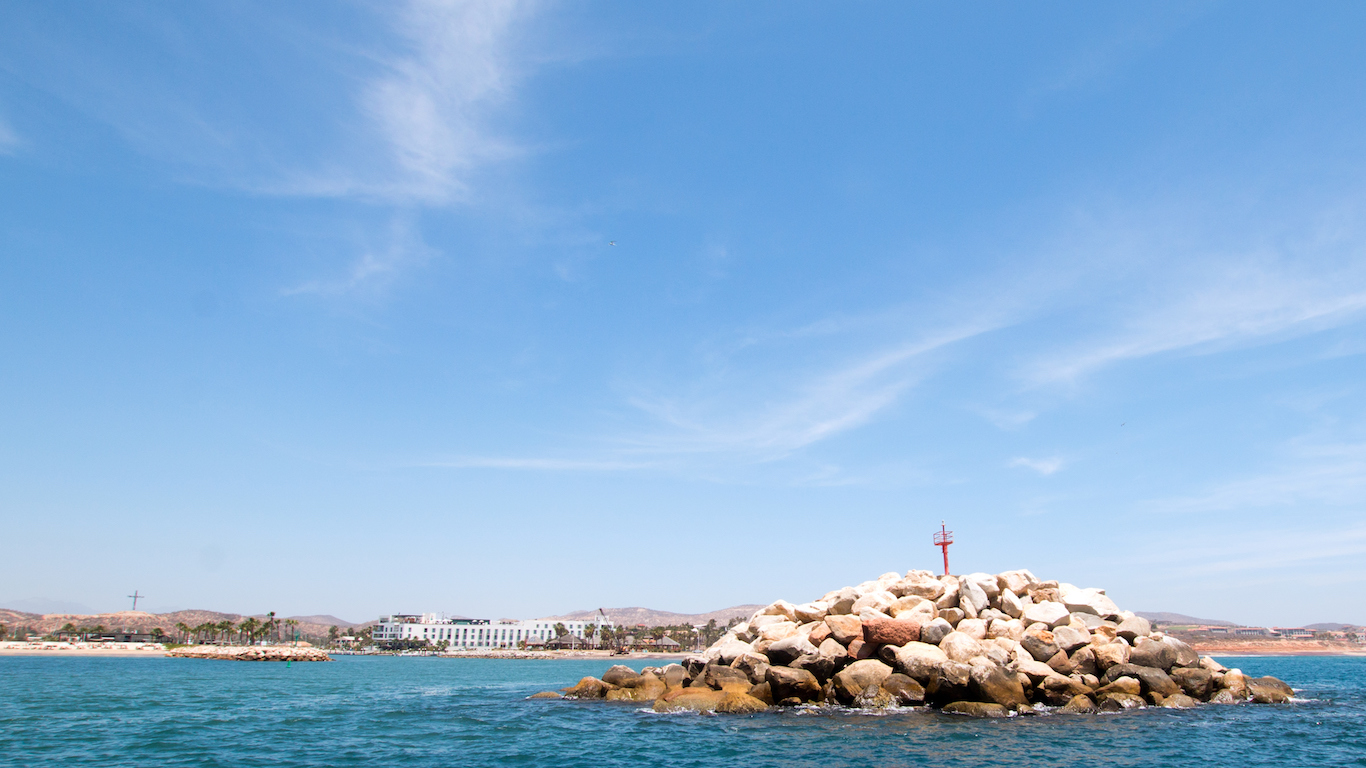
1. Los Cabos, Mexico
> Homicides per 100,000: 111.3
> 2017 homicides: 365
> Population: 328,245
One of the most disturbing trends in violent crime in Mexico is what’s happening on the southern half of the Baja California Peninsula. Both Los Cabos, which comprises the twin tourist towns of Cabo San Lucas and San José del Cabo, and the state capital of La Paz suddenly appeared on this year’s list of the world’s 50 most dangerous cities. Los Cabos reported the highest homicide rate of any of the cities Seguridad, Justicia y Paz considered — and it has not appeared in any previous annual report. The number of murders in Los Cabos jumped last year to 365 from 61 in 2016. It appears that the Gulf of California is no longer a barrier to the violent criminal activity plaguing other northwestern Mexican states.
Get Ready To Retire (Sponsored)
Start by taking a quick retirement quiz from SmartAsset that will match you with up to 3 financial advisors that serve your area and beyond in 5 minutes, or less.
Each advisor has been vetted by SmartAsset and is held to a fiduciary standard to act in your best interests.
Here’s how it works:
1. Answer SmartAsset advisor match quiz
2. Review your pre-screened matches at your leisure. Check out the advisors’ profiles.
3. Speak with advisors at no cost to you. Have an introductory call on the phone or introduction in person and choose whom to work with in the future
Thank you for reading! Have some feedback for us?
Contact the 24/7 Wall St. editorial team.



